HCUP Facts and Figures: Statistics on Hospital-based Care in the United States in 2005 presents information derived from the 2005 HCUP Nationwide Inpatient Sample (NIS) with trend information as far back as 1993. This report includes information from the most recent database containing discharge records for all patients treated in a sample of approximately 1,000 hospitals in 2005. These discharges are weighted to represent all inpatient stays in community hospitals across the nation. Community hospitals include all non-federal, short-term acute care hospitals and exclude psychiatric and substance abuse facilities.
Overall hospital statistics
The mission of the Agency for Healthcare Research and Quality (AHRQ) is to improve the quality, safety, efficiency, and effectiveness of healthcare for all Americans. To help fulfill this mission, AHRQ develops a number of databases, including the powerful Healthcare Cost and Utilization Project (HCUP). HCUP is a Federal-State-Industry partnership designed to build a standardized, multi-State health data system. HCUP features databases, software tools, and statistical reports to inform policymakers, health system leaders, researchers, and the public.
For data to be useful, they must be disseminated in a timely, accessible manner. To meet this objective, AHRQ launched HCUPnet, an interactive, Internet-based tool for identifying, tracking, analyzing, and comparing statistics on hospital utilization, outcomes, and charges (https://datatools.ahrq.gov/hcupnet). The HCUPnet user-friendly interface guides users in tailoring specific queries about hospital care online; with a click of a button, users receive answers within seconds.
To make HCUP data even more accessible, AHRQ disseminates HCUP Fact Books and online Statistical Briefs to present statistics about hospital care in easy-to-use and accessible formats (http://www.hcup-us.ahrq.gov/reports.jsp). Fact Books provide information on broad aspects of hospital care. The most recent editions cover topics of mental health and substance abuse disorders, procedures performed in hospitals, ambulatory surgeries, and safety-net hospitals. Statistical Briefs provide information on more focused healthcare topics. The most recent editions address issues of methicillin-resistant Staphylococcus aureus (MRSA) infections, musculoskeletal procedures, emergency department admissions for children and adolescents, childbirth-related hospitalizations among adolescent girls, and prostate cancer.
The most recent addition to HCUP information sources is HCUP Facts and Figures, designed to showcase the wealth of statistics available from HCUP. This edition of HCUP Facts and Figures presents an overview of the information accessible through HCUP and illustrates the types of analyses that HCUP can address. This report also provides updates on many topics presented in previously published Fact Books and Statistical Briefs. New to this report are downloadable tables and graphs to make this information even more readily available.
We invite you to tell us how you are using HCUP Facts and Figures and other HCUP data and tools, and to share suggestions on how HCUP products might be enhanced to further meet your needs. Please e-mail us at hcup@ahrq.gov or send a letter to the address below.
Irene Fraser, Ph.D.
Director
Center for Delivery, Organization, and Markets
Agency for Healthcare Research and Quality
540 Gaither Road
Rockville, MD 20850
HCUP is a family of powerful healthcare databases, software tools, and products for advancing research. Sponsored by the Agency for Healthcare Research and Quality (AHRQ), HCUP includes the largest all-payer encounter-level collection of longitudinal hospital inpatient, ambulatory surgery, and emergency department data in the United States. The HCUP Federal-State-Industry Partnership brings together the data collection efforts of many organizations—State data organizations, hospital associations, private data organizations, and the Federal government—to create this national information resource. The HCUP Partnership has grown from 8 states in 1988 to 38 in 2007.
HCUP would not be possible without the current contributions of the following data collection Partners from across the United States:
Arizona Department of Health Services
Arkansas Department of Health & Human Services
California Office of Statewide Health Planning & Development
Colorado Health & Hospital Association
Connecticut Integrated Health Information (Chime, Inc.)
Florida Agency for Health Care Administration
Georgia GHA: An Association of Hospitals & Health Systems
Hawaii Health Information Corporation
Illinois Health Care Cost Containment Council and Department of Public Health
Indiana Hospital&Health Association
Iowa Hospital Association
Kansas Hospital Association
Kentucky Department for Public Health
Maryland Health Services Cost Review Commission
Massachusetts Division of Health Care Finance and Policy
Michigan Health & Hospital Association
Minnesota Hospital Association
Missouri Hospital Industry Data Institute
Nebraska Hospital Association
Nevada Division of Health Care Financing and Policy, Department of Human Resources
New Hampshire Department of Health & Human Services
New Jersey Department of Health & Senior Services
New York State Department of Health
North Carolina Department of Health and Human Services
Ohio Hospital Association
Oklahoma State Department of Health
Oregon Association of Hospitals and Health Systems
Rhode Island Department of Health
South Carolina State Budget & Control Board
South Dakota Association of Healthcare Organizations
Tennessee Hospital Association
Texas Department of State Health Services
Utah Department of Health
Vermont Association of Hospitals and Health Systems
Virginia Health Information
Washington State Department of Health
West Virginia Health Care Authority
Wisconsin Department of Health & Family Services
Accurate and reliable hospital information is of vital importance—for a researcher investigating treatment outcomes, for a newly-diagnosed patient seeking information on the frequency with which procedures are performed, or for hospital executives researching medical trends to support purchasing decisions. The Healthcare Cost and Utilization Project (HCUP) can provide comprehensive information to help fulfill these and other needs.
Sponsored by the Agency for Healthcare Research and Quality (AHRQ), HCUP is a family of healthcare databases and related software tools and products developed through a Federal-State-Industry partnership, creating a national information resource of patient-level discharge healthcare data.
HCUP is only possible through the collective efforts of State and private data organizations, hospital associations, and the Federal government to create the single largest all-payer discharge record resource from all hospitals in the U.S.—representing more than 4,900 community, non-Federal, short-term (acute care) general and specialty hospitals. Data on conditions treated in the hospital, as well as information on medical and surgical procedures are included. HCUP data are ideal for analyzing treatment use and diagnostic trends, examining patient characteristics, conducting cost and charge studies, and investigating quality of care.
The most popular HCUP database is the Nationwide Inpatient Sample (NIS), the largest all-payer database in the U.S. The NIS contains all discharge records from approximately 1,000 hospitals in HCUP-participating states. This broad-based collection of data provides information on patient and hospital demographics, diagnoses, procedures, charges, estimated costs, payers, source of admission and discharge destinations.
HCUP Facts and Figures highlights the rich potential of HCUP by providing targeted analysis of important trends organized around high-interest topics—hospital and discharge characteristics, diagnoses, procedures, costs and charges, and the uninsured. This report was designed to illustrate the range of information available from the HCUP NIS and its capacity to track the evolution of hospital use over time.
Many of the statistics presented in this report are available online through HCUPnet (https://datatools.ahrq.gov/hcupnet). Graphical presentations, statistical tables, and bulleted notes highlight key facts and emerging trends for each topic. Downloadable tables, charts, and links to Definitions are available online by clicking on links throughout the report. In addition, a separate file containing downloadable tables and charts is available at http://www.hcup-us.ahrq.gov/reports.jsp.
HCUP has been a leader in hospital data and products and continues to be on the forefront of healthcare research in the 21st century. For more information, please visit the HCUP website at http://www.hcup-us.ahrq.gov.
Number of U.S. Registered Hospitals and Characteristics of Community Hospitals, 1997, 2004, and 2005
| Hospital Categories and Characteristics | 1997 | 2004 | 2005 |
|---|---|---|---|
| Number of U.S. registered hospitals† | 6,100 | 5,759 | 5,756 |
| Number of U.S. community hospitals | 5,060 | 4,919 | 4,936 |
| Number of non-government not-for-profit hospitals | 3,000 | 2,967 | 2,958 |
| Number of investor-owned (for-profit) community hospitals | 797 | 865 | 868 |
| Number of State and local government community hospitals | 1,260 | 1,117 | 1,110 |
| Community hospitals as a share of registered hospitals | 83% | 85% | 86% |
| Community hospitals‡ | |||
| Discharges: | |||
| Total discharges in millions | 34.7 | 38.7 | 39.2 |
| Discharges per 1,000 population* | 127.8 | 131.7 | 132.1 |
| Total days of care in millions | 168.1 | 179.1 | 181.5 |
| Average length of stay in days | 4.8 | 4.6 | 4.6 |
| Percent of discharges from: | |||
| Metropolitan hospitals | 84% | 87% | 87% |
| Teaching hospitals | 47% | 45% | 42% |
| Hospital ownership: | |||
| Non-Federal government hospitals | 14% | 14% | 14% |
| Private not-for-profit hospitals | 73% | 73% | 72% |
| Private for-profit hospitals | 13% | 13% | 13% |
| Population in millions†† | 271.4 | 293.7 | 296.4 |
† Statistics from the American Hospital Association's Annual Survey of Hospitals.
‡ Statistics from the Healthcare Cost and Utilization Project (HCUP).
* Calculated using population from the U.S. Bureau of the Census.
†† Statistics from the U.S. Bureau of the Census (http://www.census.gov/popest/).
Hospital costs rose rapidly and most hospital characteristics changed slowly over time.
Charges and Costs for Community Hospital Stays, 1997, 2004, and 2005
| Hospital Categories and Characteristics | 1997 | 2004 | 2005 |
|---|---|---|---|
| Charges and Costs* | |||
| Average charges per stay | $11,300 | $20,400 | $22,300 |
| Costs | |||
| Total aggregate costs in billions | $177.1 | $294.6 | $310.9 |
| Average costs per stay | $5,100 | $7,600 | $7,900 |
| Inflation-adjusted costs in 2005 dollars** | |||
| Total aggregate costs in billions | $209.2 | $303.5 | $310.9 |
| Average costs per stay | $6,000 | $7,900 | $7,900 |
* Charges represent amounts billed by hospitals. These amounts are seldom paid in full by insurers. Costs are calculated from charges using reported cost-to-charge ratios calculated from information on Medicare Cost Reports, reported by hospitals to the Centers for Medicare and Medicaid Services (CMS).
**Adjusted for inflation using the GDP deflator (https://www.bea.gov/data/prices-inflation/gdp-price-deflator, Table 1.1.4. Price Indexes for Gross Domestic Product).
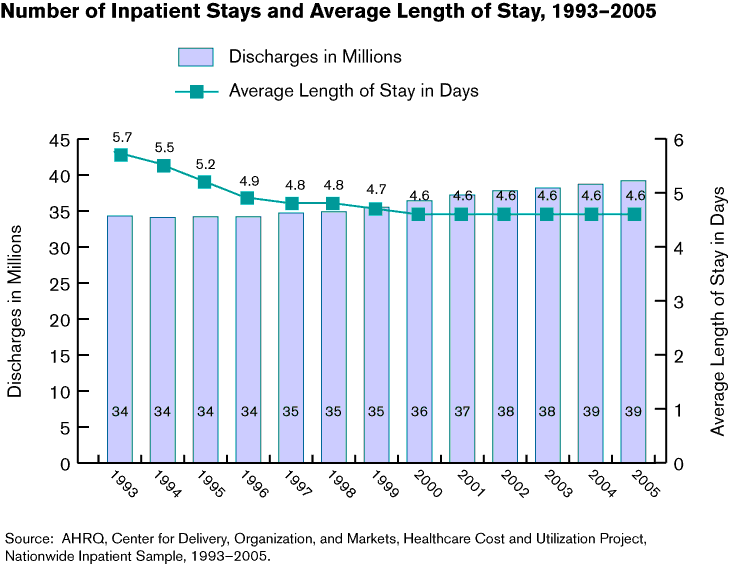
The average length of stay in U.S. community hospitals has stabilized since 2000, while the number of hospital stays continued to rise.
1Forest S, Goetghebeur M, Hay J. Forces Influencing Inpatient Hospital Costs in the United States. Chicago: Blue Cross Blue Schield Association. 2002.
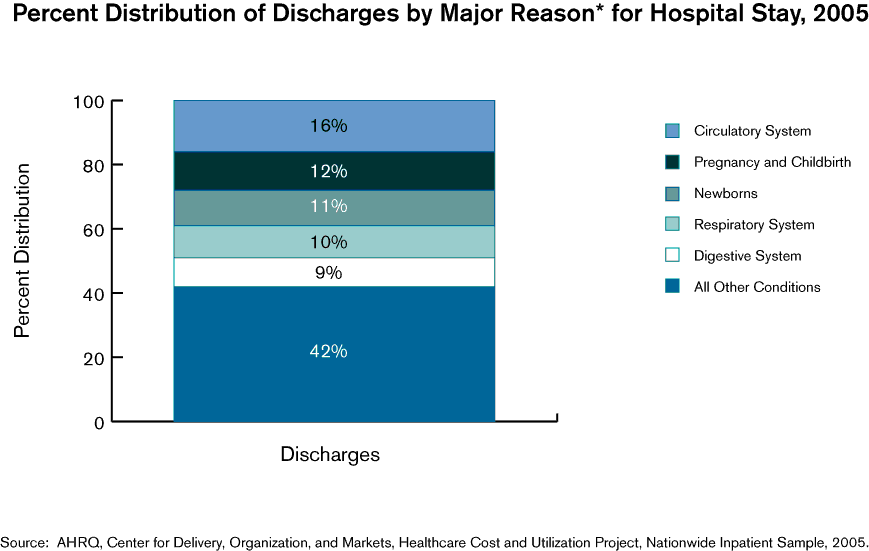
Circulatory conditions were the most frequent causes of hospital stays.
Circulatory conditions represented a higher percentage of stays for males (20 percent) than females (13 percent).
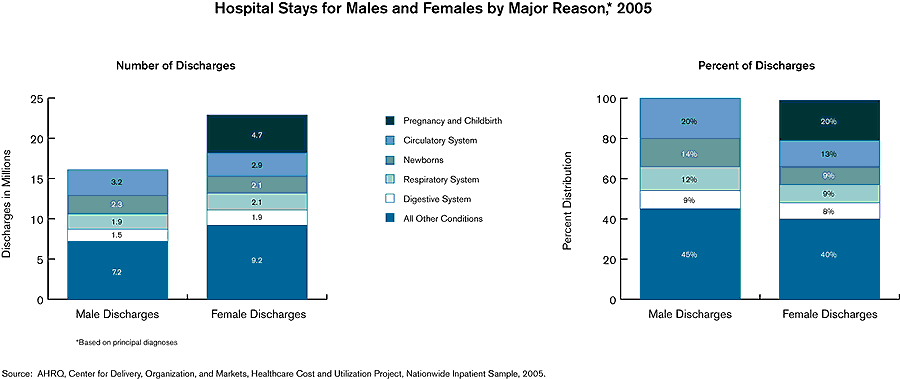
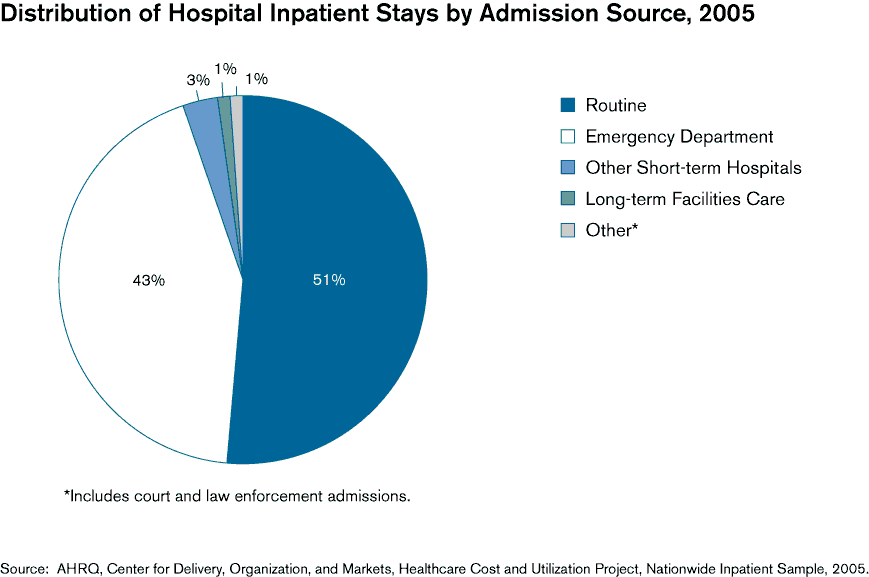
Admission source in HCUP indicates routine admission and other specific settings from which the patient might enter the hospital.
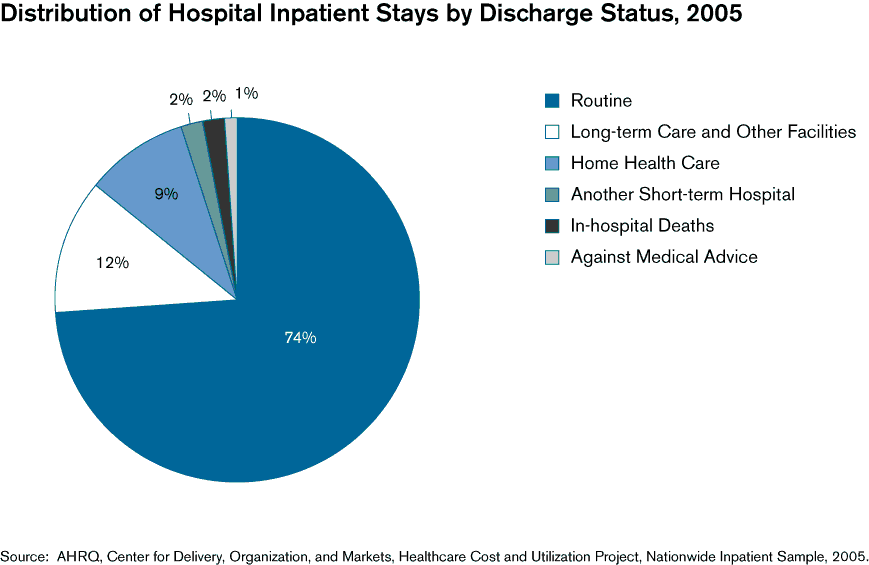
Discharge status indicates where the patient went after discharge from the hospital or the circumstance surrounding the discharge.
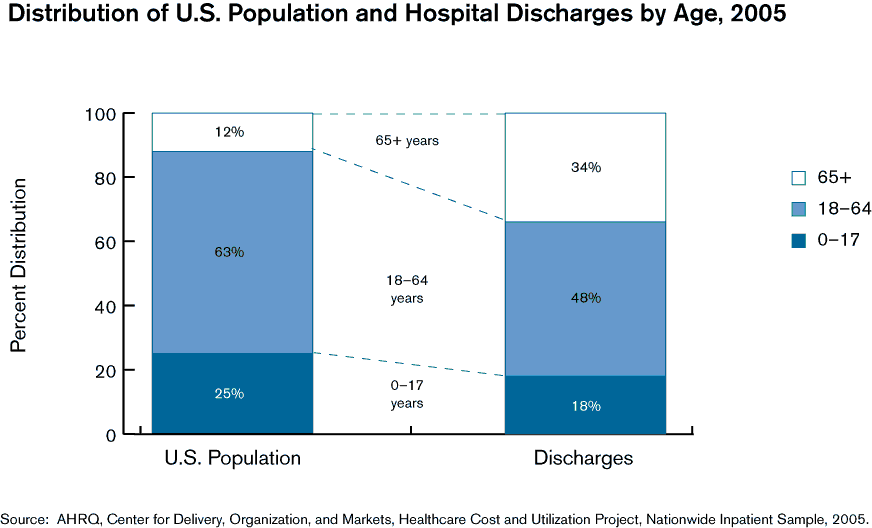
Older people account for a large share of hospitalizations.
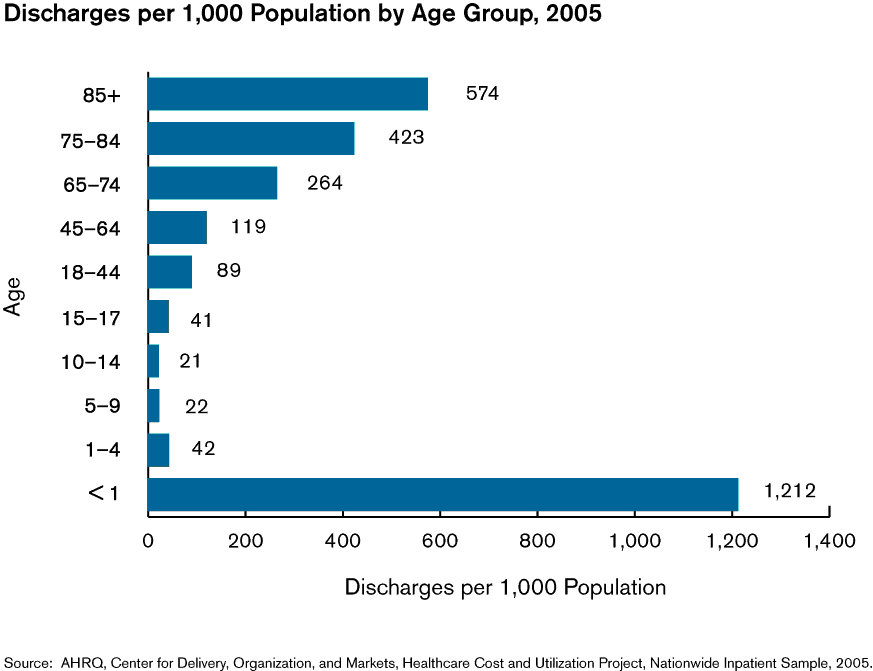
Discharges for an age group divided by the number of people in that age group (discharges per 1,000 population) shows that increased age is often associated with a greater chance of hospitalization.
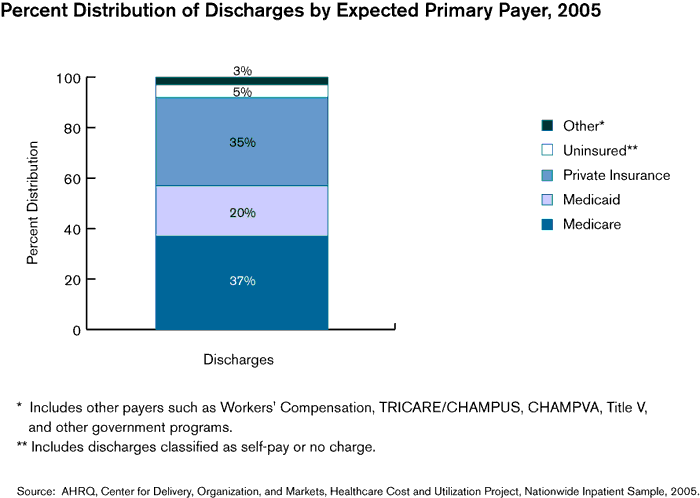
The expected primary payer bears the major financial responsibility for the hospital stay. However, other payers, including the patients themselves, may also bear part of the cost of hospitalization.
Number of Discharges, Percent Distribution, and Rank of Most Frequent Principal Diagnoses for Inpatient Hospital Stays, 1997, 2004, 2005
| PRINCIPAL DIAGNOSIS | NUMBER OF DISCHARGES IN THOUSANDS | PERCENT OF DISCHARGES | RANK | ||||||
|---|---|---|---|---|---|---|---|---|---|
| 1997 | 2004 | 2005 | 1997 | 2004 | 2005 | 1997 | 2004 | 2005 | |
| All discharges | 34,679 | 38,662 | 39,164 | 100.0 | 100.0 | 100.0 | |||
| Pregnancy, childbirth, and infants | 8,237 | 9,175 | 9,145 | 23.8 | 23.7 | 23.4 | 1 | 1 | 1 |
| Pneumonia (except that caused by tuberculosis or sexually transmitted disease) | 1,232 | 1,213 | 1,355 | 3.6 | 3.1 | 3.5 | 3 | 2 | 2 |
| Coronary atherosclerosis (coronary artery disease) | 1,407 | 1,192 | 1,110 | 4.1 | 3.1 | 2.8 | 2 | 3 | 3 |
| Congestive heart failure, nonhypertensive | 991 | 1,104 | 1,090 | 2.9 | 2.9 | 2.8 | 4 | 4 | 4 |
| Non-specific chest pain | 538 | 846 | 825 | 1.6 | 2.2 | 2.1 | 10 | 5 | 5 |
| Osteoarthritis (degenerative joint disease) | 418 | 659 | 738 | 1.2 | 1.7 | 1.9 | 17 | 9 | 6 |
| Mood disorders (depression and bipolar disorder) | 641 | 792 | 713 | 1.8 | 2.0 | 1.8 | 6 | 6 | 7 |
| Cardiac dysrhythmias (irregular heart beat) | 572 | 694 | 697 | 1.7 | 1.8 | 1.8 | 8 | 8 | 8 |
| Acute myocardial infarction (heart attack) | 732 | 695 | 662 | 2.1 | 1.8 | 1.7 | 5 | 7 | 9 |
| Spondylosis, intervertebral disc disorders, other back problems (disorders of intervertebral discs and bones in spinal column) | 536 | 616 | 647 | 1.5 | 1.6 | 1.7 | 11 | 10 | 10 |
| Chronic obstructive pulmonary disease and bronchiectasis (chronic obstructive lung disease) | 551 | 556 | 630 | 1.6 | 1.4 | 1.6 | 9 | 12 | 11 |
| Complication of medical device, implant or graft | 491 | 601 | 616 | 1.4 | 1.6 | 1.6 | 12 | 11 | 12 |
| Skin and subcutaneous tissue infections | 330 | 505 | 582 | 1.0 | 1.3 | 1.5 | 24 | 16 | 13 |
| Fluid and electrolyte disorders (primarily dehydration or fluid overload) | 468 | 555 | 574 | 1.4 | 1.4 | 1.5 | 13 | 13 | 14 |
| Septicemia (blood infection, except in labor) | 413 | 452 | 538 | 1.2 | 1.2 | 1.4 | 18 | 21 | 15 |
| All maternal discharges | 4,338 | 4,763 | 4,716 | 100.0 | 100.0 | 100.0 | |||
| Trauma to external female genitals (vulva) and area between anus and vagina (perineum), related to childbirth | 713 | 785 | 784 | 16.4 | 16.5 | 16.6 | 1 | 1 | 1 |
| Previous C-section | 271 | 456 | 481 | 6.3 | 9.6 | 10.2 | 4 | 2 | 2 |
| Normal pregnancy and/or delivery | 544 | 338 | 325 | 12.5 | 7.1 | 6.9 | 2 | 3 | 3 |
| Early or threatened labor | 261 | 255 | 236 | 6.0 | 5.4 | 5.0 | 5 | 4 | 4 |
| Fetal distress and abnormal forces of labor | 420 | 247 | 234 | 9.7 | 5.2 | 5.0 | 3 | 5 | 5 |
| Prolonged pregnancy | 104 | 218 | 234 | 2.4 | 4.6 | 5.0 | 11 | 8 | 6 |
| Hypertension complicating pregnancy, childbirth and the puerperium (high blood pressure during pregnancy) | 185 | 224 | 220 | 4.3 | 4.7 | 4.7 | 8 | 7 | 7 |
| Umbilical cord complication | 259 | 235 | 217 | 6.0 | 4.9 | 4.6 | 6 | 6 | 8 |
| Polyhydramnios and other problems of amniotic cavity (excess amniotic fluid and other problems of amniotic cavity) | 202 | 192 | 191 | 4.7 | 4.0 | 4.1 | 7 | 9 | 9 |
| All infant discharges | 3,899 | 4,411 | 4,429 | 100.0 | 100.0 | 100.0 | |||
| Liveborn (newborn infant) | 3,777 | 4,249 | 4,228 | 96.9 | 96.3 | 95.5 | 1 | 1 | 1 |
| Other perinatal conditions (other conditions occurring around the time of birth) | 56 | 72 | 94 | 1.4 | 1.6 | 2.1 | 2 | 2 | 2 |
| Hemolytic jaundice and perinatal jaundice (infant jaundice following birth) | 33 | 47 | 57 | 0.8 | 1.1 | 1.3 | 3 | 3 | 3 |
| Short gestation, low birth weight, and fetal growth retardation (premature birth and low birth weight) | 22 | 25 | 31 | 0.6 | 0.6 | 0.7 | 4 | 4 | 4 |
| Infant respiratory distress syndrome | 8 | 16 | 16 | 0.2 | 0.4 | 0.4 | 5 | 5 | 5 |
| Birth trauma | 1 | 1 | 1 | 0.0 | 0.0 | 0.0 | 7 | 6 | 6 |
| Intrauterine hypoxia and birth asphyxia (lack of oxygen to baby in uterus or during birth) | 1 | 1 | 1 | 0.0 | 0.0 | 0.0 | 6 | 7 | 7 |
| Source: AHRQ, Center for Delivery, Organization, and Markets, Healthcare Cost and Utilization Project, Nationwide Inpatient Sample, 1997, 2004 and 2005. | |||||||||
The top 15 most frequently occurring principal diagnoses accounted for half of all discharges in 2005. While 12 of the 15 most frequent principal diagnoses in 2005 were among the most frequent diagnoses in 1997, there were notable changes within the rankings.
Among all discharges:
Among maternal and infant discharges:
Number of Discharges and Percent Distribution of the Most Frequent Principal Diagnoses by Age, 1997, 2004, 2005
| AGE GROUP AND PRINCIPAL DIAGNOSIS | NUMBER OF DISCHARGES IN THOUSANDS | PERCENT OF DISCHARGES | PERCENT OF AGE-SPECIFIC TOTAL DISCHARGES | ||||||
|---|---|---|---|---|---|---|---|---|---|
| 1997 | 2004 | 2005 | 1997 | 2004 | 2005 | 1997 | 2004 | 2005 | |
| All ages* | 34,679 | 38,662 | 39,164 | ||||||
| ‹ 1 year | 4,426 | 4,898 | 4,978 | 12.8 | 12.7 | 12.7 | 100.0 | 100.0 | 100.0 |
| Liveborn (newborn infant) | 3,776 | 4,244 | 4,223 | 10.9 | 11.0 | 10.8 | 85.3 | 86.7 | 84.8 |
| Acute bronchitis | 108 | 112 | 107 | 0.3 | 0.3 | 0.3 | 2.4 | 2.3 | 2.2 |
| Hemolytic jaundice and perinatal jaundice (infant jaundice following birth) | 33 | 47 | 56 | 0.1 | 0.1 | 0.1 | 0.7 | 1.0 | 1.1 |
| Pneumonia (except that caused by tuberculosis or sexually transmitted disease) | 55 | 39 | 43 | 0.2 | 0.1 | 0.1 | 1.3 | 0.8 | 0.9 |
| Short gestation, low birth weight, and fetal growth retardation (premature birth and low birth weight) | 22 | 25 | 31 | 0.1 | 0.1 | 0.1 | 0.5 | 0.5 | 0.6 |
| 1-17 years | 1,821 | 1,784 | 2,059 | 5.3 | 4.6 | 5.3 | 100.0 | 100.0 | 100.0 |
| Pneumonia (except that caused by tuberculosis or sexually transmitted disease) | 135 | 108 | 142 | 0.4 | 0.3 | 0.4 | 7.4 | 6.0 | 6.9 |
| Asthma | 159 | 133 | 139 | 0.5 | 0.3 | 0.4 | 8.7 | 7.4 | 6.8 |
| Fluid and electrolyte disorders (primarily dehydration or fluid overload) | 64 | 79 | 98 | 0.2 | 0.2 | 0.3 | 3.5 | 4.4 | 4.8 |
| Appendicitis and other appendiceal conditions | 65 | 82 | 90 | 0.2 | 0.2 | 0.2 | 3.6 | 4.6 | 4.3 |
| Mood disorders (depression and bipolar disorder) | 64 | 84 | 73 | 0.2 | 0.2 | 0.2 | 3.5 | 4.7 | 3.6 |
| 18-44 years | 9,444 | 10,323 | 10,041 | 27.2 | 26.7 | 25.6 | 100.0 | 100.0 | 100.0 |
| Trauma to external female genitals (vulva) and area between anus and vagina (perineum), related to childbirth | 676 | 754 | 753 | 1.9 | 2.0 | 1.9 | 7.2 | 7.3 | 7.5 |
| Previous C-section | 270 | 453 | 478 | 0.8 | 1.2 | 1.2 | 2.9 | 4.4 | 4.8 |
| Mood disorders (depression and bipolar disorder) | 335 | 416 | 364 | 1.0 | 1.1 | 0.9 | 3.5 | 4.0 | 3.6 |
| Normal pregnancy and/or delivery | 511 | 323 | 312 | 1.5 | 0.8 | 0.8 | 5.4 | 3.1 | 3.1 |
| Fetal distress and abnormal forces of labor | 399 | 238 | 224 | 1.2 | 0.6 | 0.6 | 4.2 | 2.3 | 2.2 |
| 45-64 years | 6,496 | 8,546 | 8,660 | 18.7 | 22.1 | 22.1 | 100.0 | 100.0 | 100.0 |
| Coronary atherosclerosis (coronary artery disease) | 526 | 492 | 461 | 1.5 | 1.3 | 1.2 | 8.1 | 5.8 | 5.3 |
| Non-specific chest pain | 242 | 396 | 388 | 0.7 | 1.0 | 1.0 | 3.7 | 4.6 | 4.5 |
| Osteoarthritis (degenerative joint disease) | 105 | 235 | 272 | 0.3 | 0.6 | 0.7 | 1.6 | 2.7 | 3.1 |
| Pneumonia (except that caused by tuberculosis or sexually transmitted disease) | 199 | 246 | 271 | 0.6 | 0.6 | 0.7 | 3.1 | 2.9 | 3.1 |
| Spondylosis, intervertebral disc disorders, other back problems (disorders of intervertebral discs and bones in spinal column) | 190 | 249 | 266 | 0.5 | 0.6 | 0.7 | 2.9 | 2.9 | 3.1 |
| 65+ years | 12,482 | 13,059 | 13,374 | 36.0 | 33.8 | 34.2 | 100.0 | 100.0 | 100.0 |
| Congestive heart failure, nonhypertensive | 783 | 820 | 815 | 2.3 | 2.1 | 2.1 | 6.3 | 6.3 | 6.1 |
| Pneumonia (except that caused by tuberculosis or sexually transmitted disease) | 711 | 713 | 781 | 2.0 | 1.8 | 2.0 | 5.7 | 5.5 | 5.8 |
| Coronary atherosclerosis (coronary artery disease) | 810 | 641 | 596 | 2.3 | 1.7 | 1.5 | 6.5 | 4.9 | 4.5 |
| Cardiac dysrhythmias (irregular heart beat) | 402 | 477 | 469 | 1.2 | 1.2 | 1.2 | 3.2 | 3.7 | 3.5 |
| Osteoarthritis (degenerative joint disease) | 300 | 405 | 419 | 0.9 | 1.0 | 1.1 | 2.4 | 2.9 | 3.1 |
| Source: Healthcare Cost and Utilization Project (HCUP), Agency for Healthcare Research and Quality. *Includes a small number of discharges (less than 55,000 or 0.1 percent) with missing age. | |||||||||
The principal diagnoses for hospitalizations generally varied by age. Older patients were more frequently admitted with cardiovascular and musculoskeletal conditions and younger patients were more frequently admitted with pregnancy- and childbirth-related conditions.
Number of Discharges,* Percent Distribution, and Rank of Most Frequent Principal Diagnoses for Inpatient Hospital Stays by Sex, 2005
| PRINCIPAL DIAGNOSIS | MALES | FEMALES | ||||
|---|---|---|---|---|---|---|
| NUMBER OF DISCHARGES IN THOUSANDS | PERCENT OF MALE DISCHARGES | RANK | NUMBER OF DISCHARGES IN THOUSANDS | PERCENT OF FEMALE DISCHARGES | RANK | |
| All diagnoses | 16,053 | 100.0 | 22,980 | 100.0 | ||
| Pregnancy and childbirth | - | - | - | 4,705 | 20.5 | 1 |
| Liveborn (newborn infant) | 2,160 | 13.5 | 1 | 2,058 | 9.0 | 2 |
| Coronary atherosclerosis (coronary artery disease) | 691 | 4.3 | 2 | 418 | 1.8 | 7 |
| Pneumonia (except that caused by tuberculosis or sexually transmitted disease) | 645 | 4.0 | 3 | 708 | 3.1 | 3 |
| Congestive heart failure, nonhypertensive | 524 | 3.3 | 4 | 566 | 2.5 | 4 |
| Acute myocardial infarction (heart attack) | 392 | 2.4 | 5 | 270 | 1.2 | 20 |
| Non-specific chest pain | 365 | 2.3 | 6 | 459 | 2.0 | 5 |
| Cardiac dysrhythmias (irregular heart beat) | 341 | 2.1 | 7 | 355 | 1.5 | 10 |
| Complication of medical device, implant or graft | 316 | 2.0 | 8 | 298 | 1.3 | 15 |
| Skin and subcutaneous tissue infections | 307 | 1.9 | 9 | 273 | 1.2 | 19 |
| Spondylosis, intervertebral disc disorders, other back problems (disorders of intervertebral discs and bones in spinal column) | 304 | 1.9 | 10 | 339 | 1.5 | 13 |
| Mood disorders (depression and bipolar disorders) | 296 | 1.8 | 11 | 414 | 1.8 | 8 |
| Osteoarthritis (degenerative joint disease) | 280 | 1.7 | 12 | 455 | 2.0 | 6 |
| Urinary tract infections | 151 | 0.9 | 27 | 377 | 1.6 | 9 |
| Source: Healthcare Cost and Utilization Project (HCUP), Agency for Healthcare Research and Quality. *Excludes a small number of discharges (less than 135,000 or 0.3 percent) with missing sex. | ||||||
Most diagnoses are common to both males and females if those related to childbirth are excluded. However, some diagnoses were more frequent in one sex, in part because of differences between males and females in health-seeking behaviors and attitudes.
In general, longer lengths of stay are associated with higher average charges. While full charges are seldom paid because of negotiated discounts, they can be used as a benchmark for comparing the costliness of different types of hospital stays.
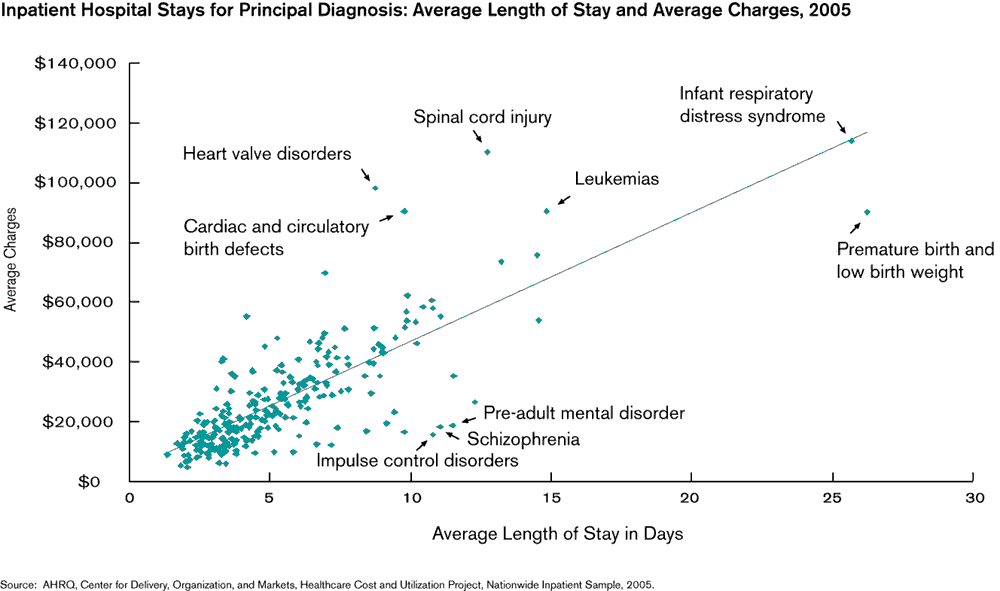
Although the share of all discharges for circulatory disease was essentially equal between male (51 percent) and female (49 percent) in 2005, the sex share differed according to conditions.
| Principal Diagnosis | Total* | Male | Female | ||
|---|---|---|---|---|---|
| Discharges in Thousands | Percent Male | Rank for Males | Percent Female | Rank for Females | |
| All circulatory disease discharges | 6,627 | 51 | 49 | ||
| Coronary atherosclerosis (coronary artery disease) | 1,110 | 62 | 1 | 38 | 3 |
| Congestive heart failure, nonhypertensive | 1,090 | 48 | 2 | 52 | 1 |
| Acute myocardial infarction (heart attack) | 662 | 59 | 3 | 41 | 6 |
| Non-specific chest pain | 825 | 44 | 4 | 56 | 2 |
| Cardiac dysrhythmias (irregular heart beat) | 697 | 49 | 5 | 51 | 4 |
| Acute cerebrovascular disease (stroke) | 526 | 46 | 6 | 54 | 5 |
| Hypertension with complications and secondary hypertension (high blood pressure with complications) | 215 | 46 | 7 | 54 | 7 |
| Peripheral and visceral atherosclerosis (hardening of arteries other than heart) | 183 | 46 | 8 | 54 | 9 |
| Occlusion or stenosis of precerebral arteries (blockage of arteries before brain) | 141 | 57 | 9 | 43 | 13 |
| Transient cerebral ischemia (mini-stroke) | 183 | 40 | 10 | 60 | 8 |
| Phlebitis, thrombophlebitis, and thromboembolism (inflammation and blood clots in the veins) | 161 | 45 | 11 | 55 | 10 |
| Source: Healthcare Cost and Utilization Project (HCUP), Agency for Healthcare Research and Quality. * Includes a small number of discharges (less than 5,500 or 0.1 percent) with missing sex. |
|||||
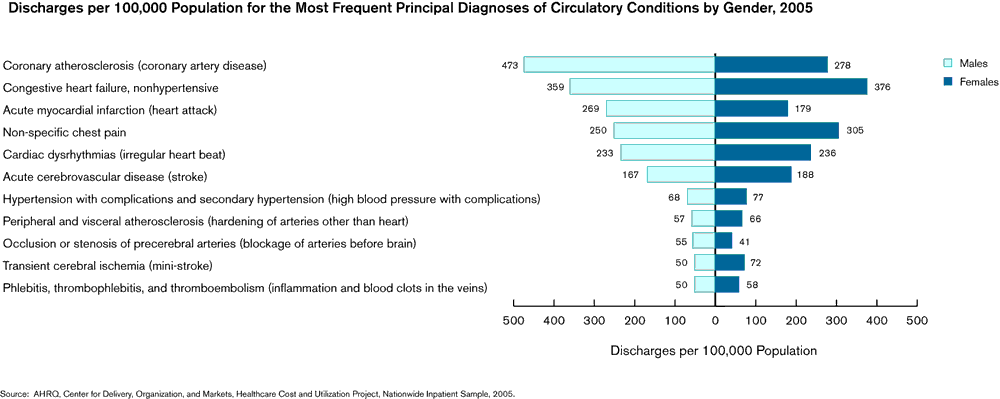
Diabetes is a chronic condition characterized by high levels of blood glucose that can lead to serious complications, including lower limb amputations and premature death. There were 2,200 diabetes-related hospitalizations per 100,000 people in the U.S. The prevalence of diabetes discharges, however, varied across age, region, and income.
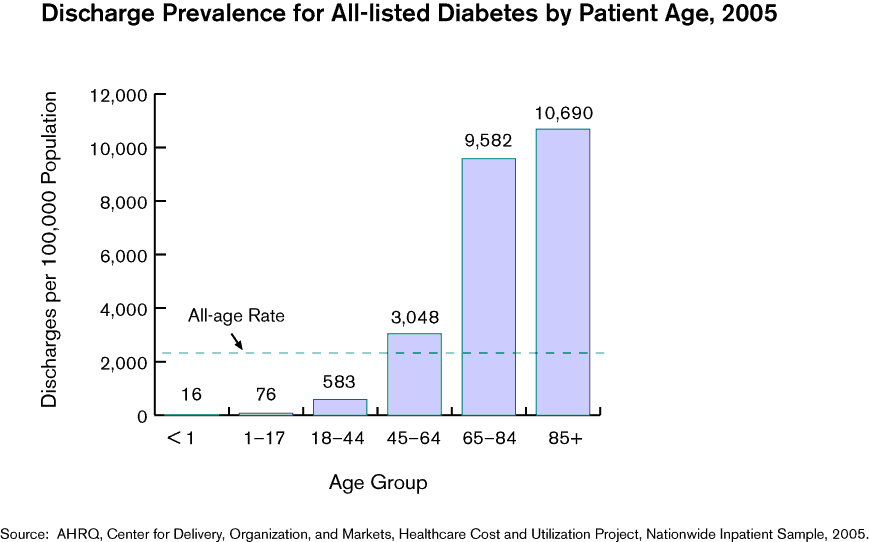
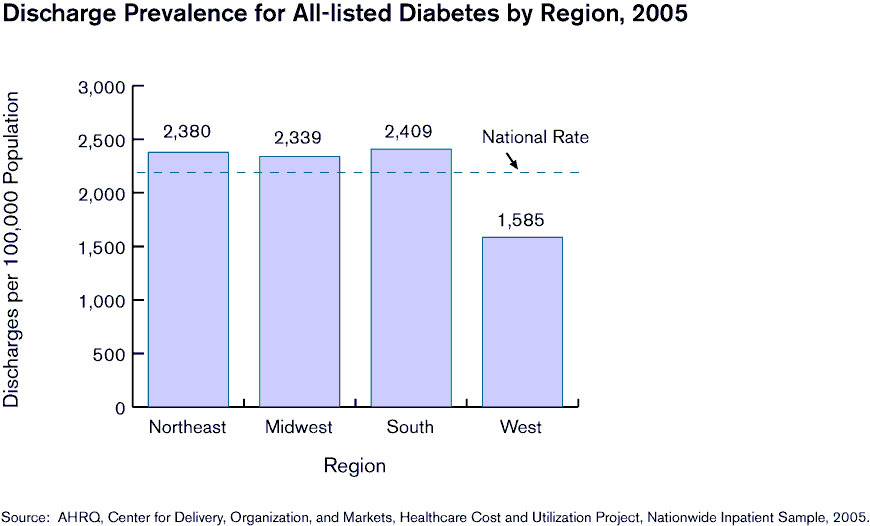
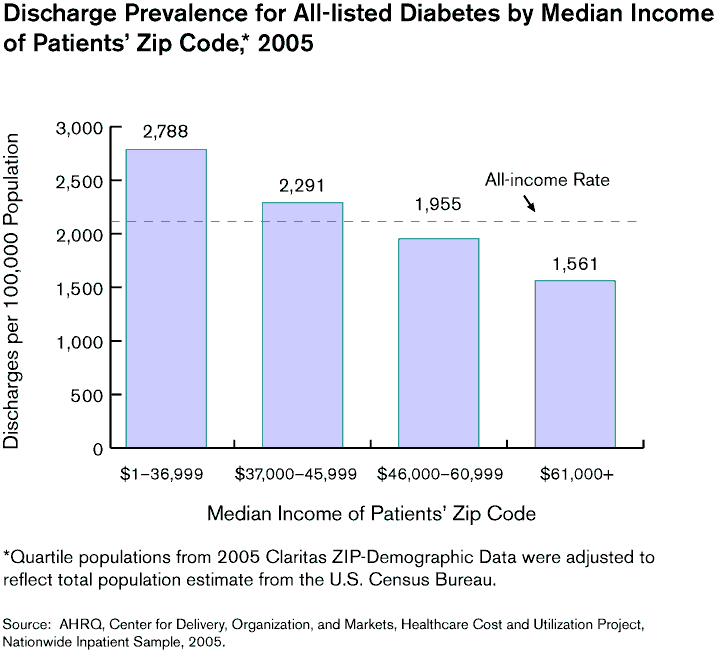
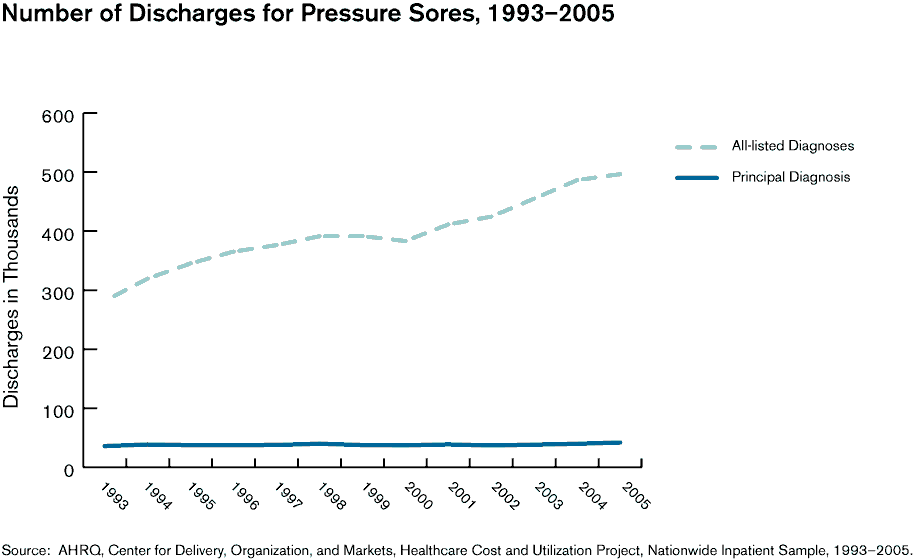
Pressure sores typically result from prolonged periods of uninterrupted pressure on the skin, soft tissue, muscle, and bone. This often occurs in wheelchair- or bedridden-patients whose positions are not changed regularly. The presence of pressure sores for patients in the hospital increases their lengths of stay and total costs.
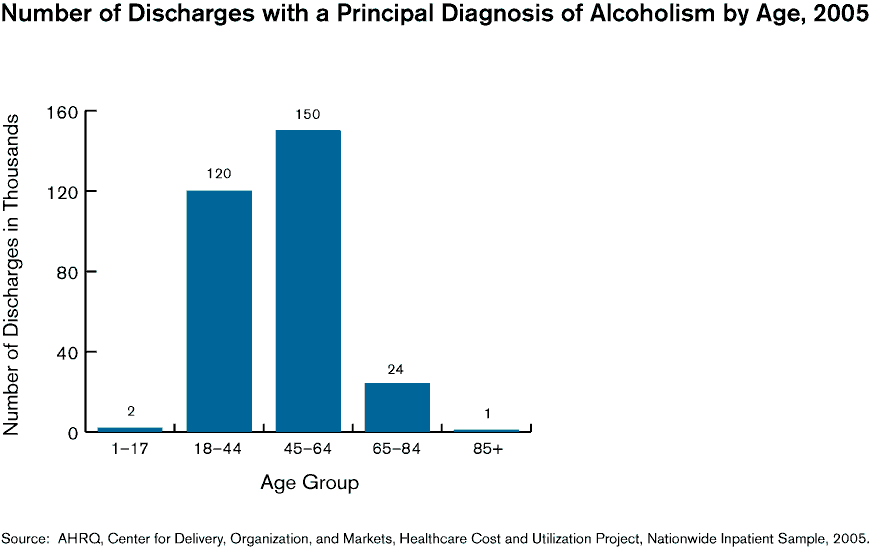
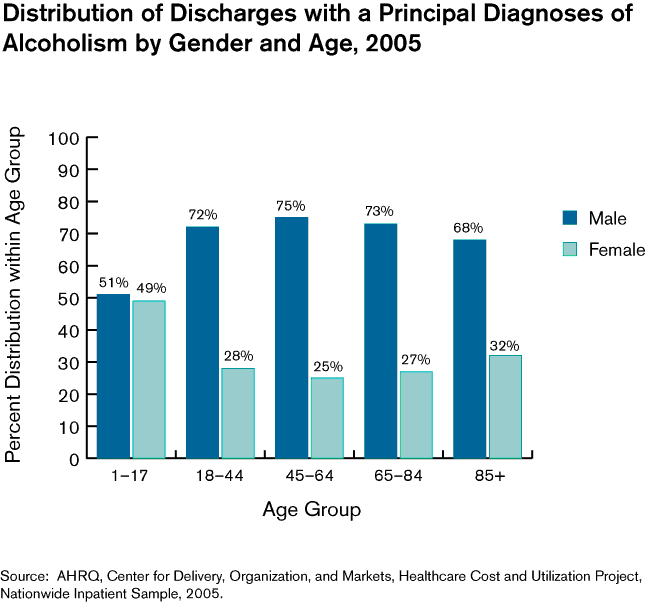
Alcohol abuse and dependence can result in illness, disability, and early death. About 14 million Americans abuse or have a dependency on alcohol. More than half of American adults have a close family member who has suffered from alcoholism.1
1U.S. Department of Health and Human Services. National Institute on Alcohol Abuse and Alcoholism. Alcohol Research & Health: Highlights from the Tenth Special Report to Congress—Health Risks and Benefits of Alcohol Consumption (Volume 24, Number 1). Washington, D.C.: U.S. Government Printing Office, 2000. Retrieved April 27, 2006, at http://pubs.niaaa.nih.gov/publications/arh24-1/05-11.pdf.
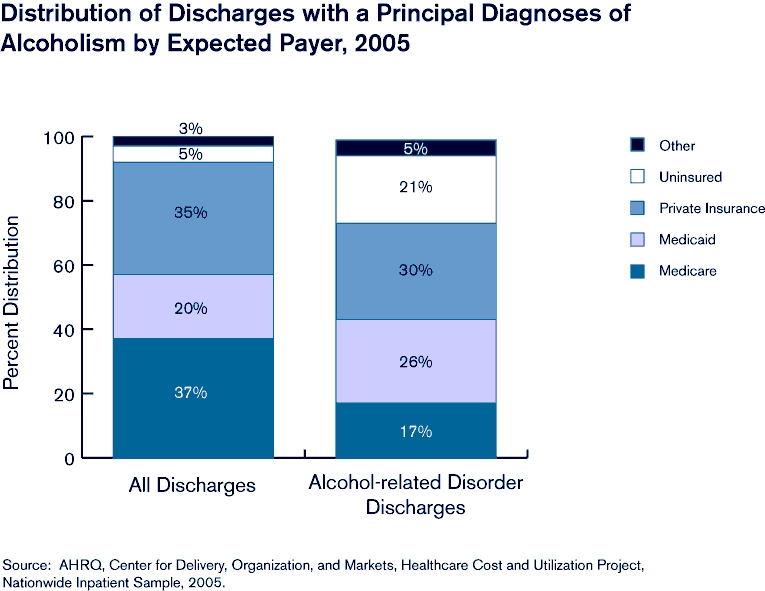
The data for this report exclude discharges from mental health and substance abuse facilities. Nevertheless, mood disorders were the seventh most frequent reason for hospital admission in 2005 (see Exhibit 2.1). Mood disorders represented only one of many mental health conditions for which people were hospitalized in that year. These conditions generally differed with age.
Youth less than 18 years of age:
Patients 18–44 years of age:
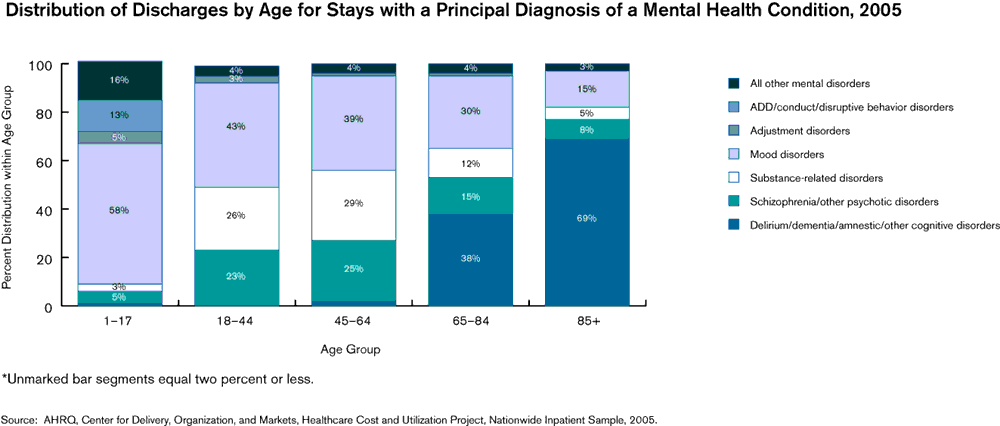
Patients 45–64 years of age:
Patients ages 65–84 years and ages 85 years and older:
| Principal Diagnosis | Total Number of Stays in Thousands | Average Costs per Stay | Average Length of Stay in Days | In-hospital Death Rate (Percent) | |
|---|---|---|---|---|---|
| All injuries | 1,891 | $10,300 | 4.6 | 3.1 | |
| Spinal cord injury | 12 | 38,800 | 12.7 | 5.9 | |
| Crushing injury or internal injury | 106 | 16,900 | 6.7 | 3.4 | |
| Intracranial injury (brain injury) | 171 | 16,500 | 6.4 | 9.1 | |
| Burns | 41 | 15,300 | 7.1 | 2.4 | |
| Fracture of neck of femur (hip fracture) | 317 | 12,300 | 6.3 | 2.8 | |
| Fracture of lower limb (leg) | 267 | 10,600 | 4.6 | 0.5 | |
| Other fractures | 194 | 10,100 | 5.3 | 1.4 | |
| Skull and face fractures | 53 | 9,600 | 3.4 | 0.4 | |
| Joint disorders and dislocations, trauma-related | 33 | 9,100 | 3.1 | 0.3 | |
| Fracture of upper limb (arm) | 154 | 8,000 | 3.2 | 0.4 | |
| Open wounds of extremities (arms and legs) | 50 | 7,100 | 3.5 | 0.2 | |
| Other injuries and conditions due to external causes | 102 | 7,000 | 3.5 | 3.3 | |
| Open wounds of head, neck, and trunk | 38 | 6,900 | 2.6 | 0.6 | |
| Poisoning by nonmedicinal substances (substances other than medicine) | 25 | 6,700 | 3.1 | 1.7 | |
| Poisoning by other medications and drugs | 155 | 5,500 | 2.9 | 1.2 | |
| Sprains and strains | 45 | 5,400 | 2.6 | 0.2 | |
| Superficial injury, contusion (bruise) | 53 | 4,900 | 3.4 | 0.6 | |
| Poisoning by psychotropic agents (psychiatric drugs) | 77 | 4,800 | 2.5 | 0.8 | |
| Source: AHRQ, Center for Delivery, Organization, and Markets, Healthcare Cost and Utilization Project, Nationwide Inpatient Sample, 2005. | |||||
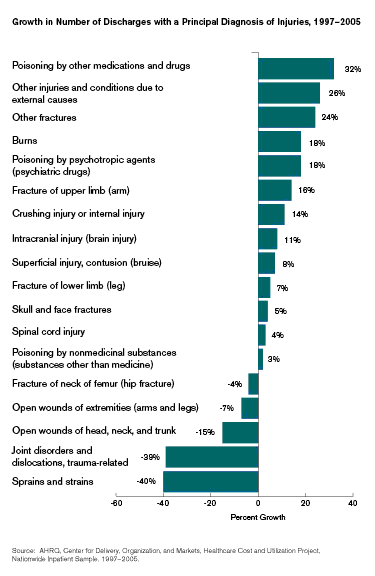
In 2005, nearly 5 percent of all hospital stays—about 1.9 million hospitalizations—were for treatment of an injury. Costs, lengths of stay, and hospital death rates differed according to the type of injury.
Over time, the number of hospitalizations associated with each injury has changed.
| Characteristics | All Hospital Stays | Hospital Stays for Influenza |
|---|---|---|
| Total number of discharges in thousands | 39,164 | 50 |
| Mean length of stay in days | 4.6 | 4.1 |
| Mean cost of hospitalization | $7,900 | $5,400 |
| Mean hospital cost per day | $1,700 | $1,300 |
| Aggregate costs for U.S. in millions | $310,916.2 | $272.0 |
| Percent of admissions through the emergency department | 43% | 68% |
| Percent died in hospital | 2.1% | 1.6% |
| Percent < 1 year (excluding newborns*) | 2% | 11% |
| Percent 1-64 years | 53% | 38% |
| Percent 65 years and above | 34% | 51% |
| Source: Healthcare Cost and Utilization Project (HCUP), Agency for Healthcare Research and Quality. *Newborns account for 11 percent of all hospital discharges. |
||
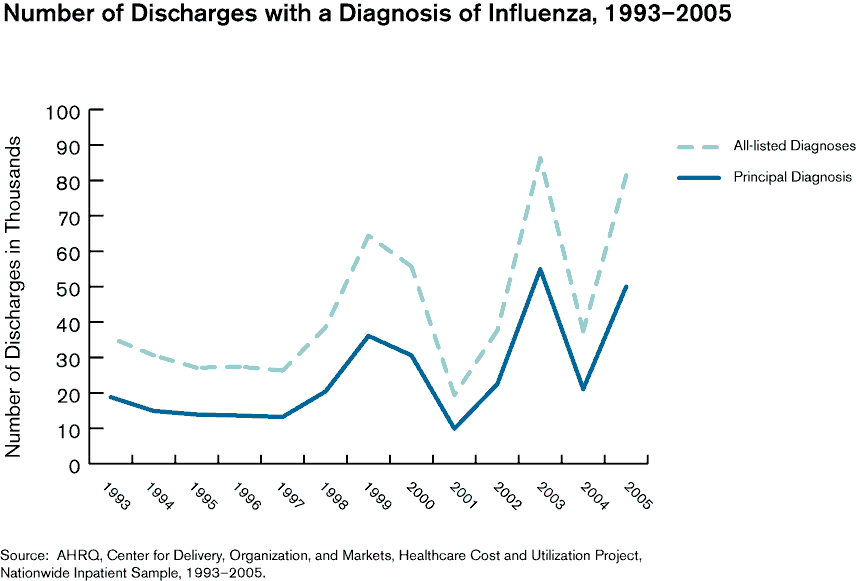
Influenza (flu) is a contagious respiratory viral disease. In 2005, there were over 50,000 hospital stays principally for influenza, resulting in about $272 million in aggregate costs.
2Centers for Disease Control and Prevention. Influenza (Flu): Clinical Description and Diagnosis. August 23, 2006. http://www.cdc.gov/flu/professionals/diagnosis/
| All-listed Procedures | Number of Stays with the Procedure in Thousands | Percent of Discharges with the Procedure | Rank | ||||||
|---|---|---|---|---|---|---|---|---|---|
| 1997 | 2004 | 2005 | 1997 | 2004 | 2005 | 1997 | 2004 | 2005 | |
| All discharges | 34,679 | 38,662 | 39,164 | ||||||
| All discharges with procedure | 21,187 | 23,835 | 24,145 | 100.0 | 100.0 | 100.0 | |||
| Blood transfusion | 1,098 | 2,228 | 2,359 | 5 | 9 | 10 | 5 | 1 | 1 |
| Diagnostic cardiac catheterization, coronary arteriography (diagnostic procedure to explore the functioning of the heart) | 1,461 | 1,611 | 1,589 | 7 | 7 | 7 | 1 | 2 | 2 |
| Repair of obstetric laceration | 1,137 | 1,342 | 1,334 | 5 | 6 | 6 | 3 | 3 | 3 |
| Cesarean section (C-section) | 800 | 1,271 | 1,304 | 4 | 5 | 5 | 9 | 4 | 4 |
| Circumcision | 1,164 | 1,212 | 1,237 | 5 | 5 | 5 | 2 | 7 | 5 |
| Upper gastrointestinal endoscopy (procedure to view and biopsy the esophagus, stomach, and first portion of intestine through a lighted tube) | 1,105 | 1,267 | 1,224 | 5 | 5 | 5 | 4 | 5 | 6 |
| Respiratory intubation and mechanical ventilation | 919 | 1,240 | 1,223 | 4 | 5 | 5 | 7 | 6 | 7 |
| Prophylactic vaccinations and inoculations | 567 | 849 | 954 | 3 | 4 | 4 | 14 | 10 | 8 |
| Fetal monitoring | 1,002 | 1,047 | 911 | 5 | 4 | 4 | 6 | 8 | 9 |
| Artificial rupture of membranes to assist delivery | 747 | 866 | 885 | 4 | 4 | 4 | 10 | 9 | 10 |
| Source: Healthcare Cost and Utilization Project (HCUP), Agency for Healthcare Research and Quality | |||||||||
Rankings of the top 10 most frequently performed procedures were based on all-listed procedures.
| Age Group and All-listed Procedures | Number of Discharges in Thousands | Percent of All Discharges | Percent of Age-specific Discharges | |||||||
|---|---|---|---|---|---|---|---|---|---|---|
| 1997 | 2004 | 2005 | 1997 | 2004 | 2005 | 1997 | 2004 | 2005 | ||
| All discharges, all ages† | 34,679 | 38,662 | 39,164 | 100.0 | 100.0 | 100.0 | ||||
| < 1 year | 4,426 | 4,898 | 4,978 | 12.8 | 12.7 | 12.7 | 100.0 | 100.0 | 100.0 | |
| Circumcision | 1,159 | 1,206 | 1,232 | 3.3 | 3.1 | 3.1 | 26.2 | 24.6 | 24.7 | |
| Prophylactic vaccinations and inoculations | 549 | 794 | 865 | 1.6 | 2.1 | 2.2 | 12.4 | 16.2 | 17.4 | |
| Ophthalmologic and otologic diagnosis and treatment (vision and hearing diagnosis and treatment) | * | 339 | 471 | * | 0.9 | 1.2 | * | 6.9 | 9.5 | |
| Respiratory intubation and mechanical ventilation | 163 | 214 | 196 | 0.5 | 0.6 | 0.5 | 3.7 | 4.4 | 3.9 | |
| Diagnostic spinal tap | 147 | 104 | 125 | 0.4 | 0.3 | 0.3 | 3.3 | 2.1 | 2.5 | |
| 1-17 years, all discharges | 1,821 | 1,784 | 2,059 | 5.3 | 4.6 | 5.3 | 100.0 | 100.0 | 100.0 | |
| Appendectomy (removal of appendix) | 74 | 87 | 95 | 0.2 | 0.2 | 0.2 | 4.1 | 4.9 | 4.6 | |
| Cancer chemotherapy | 43 | 46 | 64 | 0.1 | 0.1 | 0.2 | 2.4 | 2.6 | 3.1 | |
| Blood transfusion | 26 | 52 | 59 | 0.1 | 0.1 | 0.2 | 1.4 | 2.9 | 2.9 | |
| Repair of obstetric laceration | 58 | 53 | 54 | 0.2 | 0.1 | 0.1 | 3.2 | 3.0 | 2.6 | |
| Diagnostic spinal tap | 43 | 47 | 49 | 0.1 | 0.1 | 0.1 | 2.4 | 2.6 | 2.4 | |
| 18-44 years, all discharges | 9,444 | 10,323 | 10,041 | 26.7 | 25.6 | 100.0 | 100.0 | 100.0 | ||
| Repair of obstetric laceration | 1,079 | 1,287 | 1,278 | 3.1 | 3.3 | 3.3 | 11.4 | 12.5 | 12.7 | |
| Cesarean section (C-section) | 773 | 1,238 | 1,270 | 2.2 | 3.2 | 3.2 | 8.2 | 12.0 | 12.6 | |
| Fetal monitoring | 952 | 1,005 | 876 | 2.7 | 2.6 | 2.2 | 10.1 | 9.7 | 8.7 | |
| Artificial rupture of membranes to assist delivery | 706 | 830 | 850 | 2.0 | 2.1 | 2.2 | 7.5 | 8.0 | 8.5 | |
| Episiotomy (surgical incision into the perineum and vagina to prevent traumatic tearing during delivery) | 813 | 490 | 418 | 2.3 | 1.3 | 1.1 | 8.6 | 4.7 | 4.2 | |
| 45-64 years, all discharges | 6,496 | 8,546 | 8,660 | 18.7 | 22.1 | 22.1 | 100.0 | 100.0 | 100.0 | |
| Diagnostic cardiac catheterization, coronary arteriography (diagnostic procedure to explore the functioning of the heart) | 578 | 681 | 674 | 1.7 | 1.8 | 1.7 | 8.9 | 8.0 | 7.8 | |
| Blood transfusion | 247 | 568 | 601 | 0.7 | 1.5 | 1.5 | 3.8 | 6.6 | 6.9 | |
| Upper gastrointestinal endoscopy (procedure to view and biopsy the esophagus, stomach and first portion of intestine through a lighted tube) | 275 | 369 | 356 | 0.8 | 1.0 | 0.9 | 4.2 | 4.3 | 4.1 | |
| PTCA (percutaneous transluminal coronary angioplasty, procedure involving use of a balloon-tipped catheter to enlarge a narrowed artery) | 247 | 344 | 349 | 0.7 | 0.9 | 0.9 | 3.8 | 4.0 | 4.0 | |
| Respiratory intubation and mechanical ventilation | 186 | 312 | 310 | 0.5 | 0.8 | 0.8 | 2.9 | 3.7 | 3.6 | |
| 65+ years, all discharges | 12,484 | 13,059 | 13,374 | 36.0 | 33.8 | 34.2 | 100.0 | 100.0 | 100.0 | |
| Blood transfusion | 652 | 1,294 | 1,377 | 1.9 | 3.3 | 3.5 | 5.2 | 9.9 | 10.3 | |
| Diagnostic cardiac catheterization, coronary arteriography (diagnostic procedure to explore the functioning of the heart) | 773 | 805 | 789 | 2.2 | 2.1 | 2.0 | 6.2 | 6.2 | 5.9 | |
| Upper gastrointestinal endoscopy (procedure to view and biopsy the esophagus, stomach and first portion of intestine through a lighted tube) | 653 | 689 | 666 | 1.9 | 1.8 | 1.7 | 5.2 | 5.3 | 5.0 | |
| Respiratory intubation and mechanical ventilation | 431 | 516 | 524 | 1.2 | 1.3 | 1.3 | 3.5 | 4.0 | 3.9 | |
| PTCA (percutaneous transluminal coronary angioplasty, procedure involving use of a balloon-tipped catheter to enlarge a narrowed artery) | 299 | 405 | 409 | 0.9 | 1.0 | 1.0 | 2.4 | 3.1 | 3.1 | |
| Source: Healthcare Cost and Utilization Project (HCUP), Agency for Healthcare Research and Quality. *Statistics based on estimates with a relative standard error (standard error/weighted estimate) greater than 0.30 or with standard error = 0 in the nationwide statistics are not reliable. † Includes a small number of discharges (less than 55,000 or 0.1 percent) with missing age. |
||||||||||
The most frequent procedures usually varied by age group, except for individuals ages 45–64 and ages 65 and above: these two groups had in common the five most frequently performed procedures.

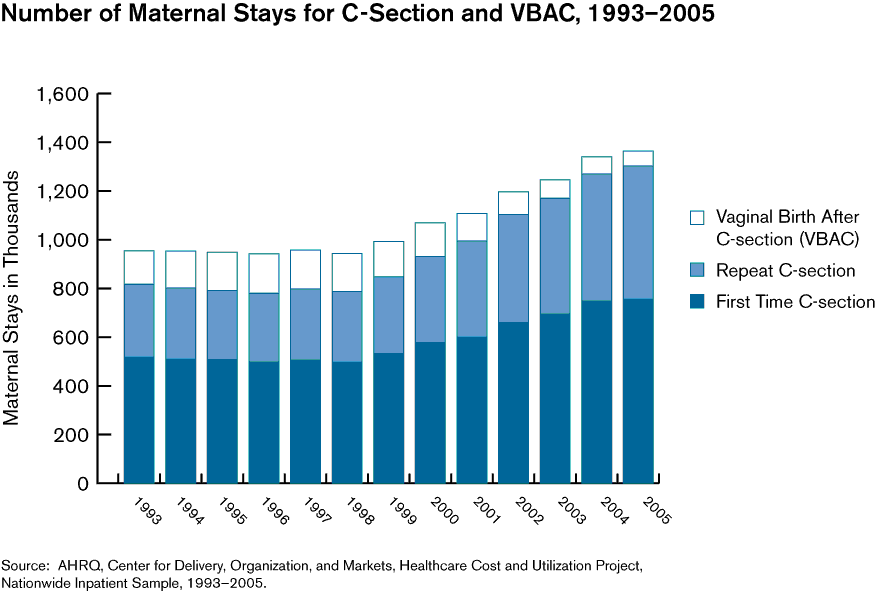
Pregnancy and childbirth is the second most common reason for admission to the hospital (see Exhibit 1.3). The types of procedures used for childbirth have changed over time.
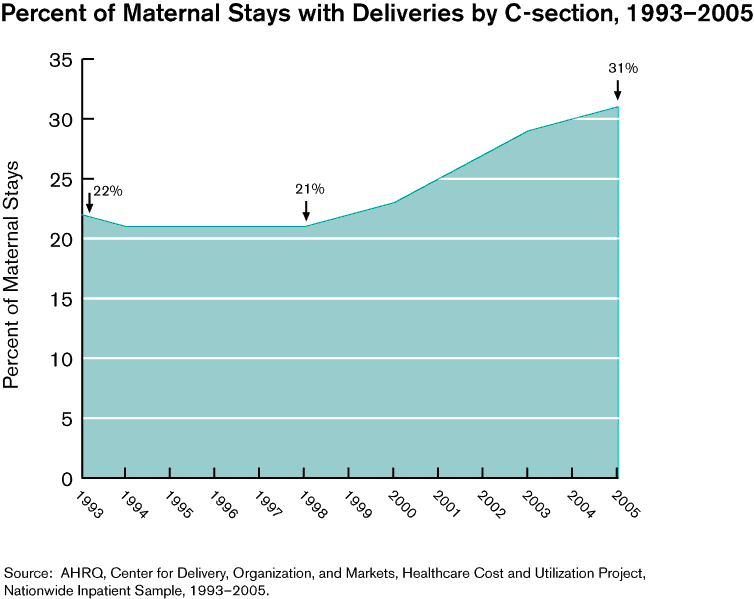
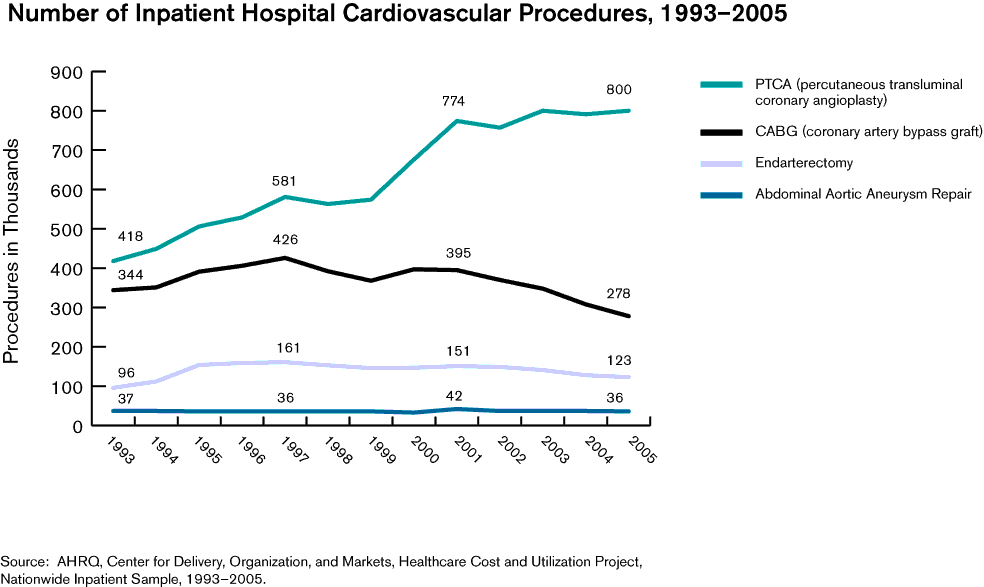
Cardiovascular procedures to treat heart disease and stroke are the most common reasons for admission to the hospital for both men and women, excluding pregnancy and childbirth.
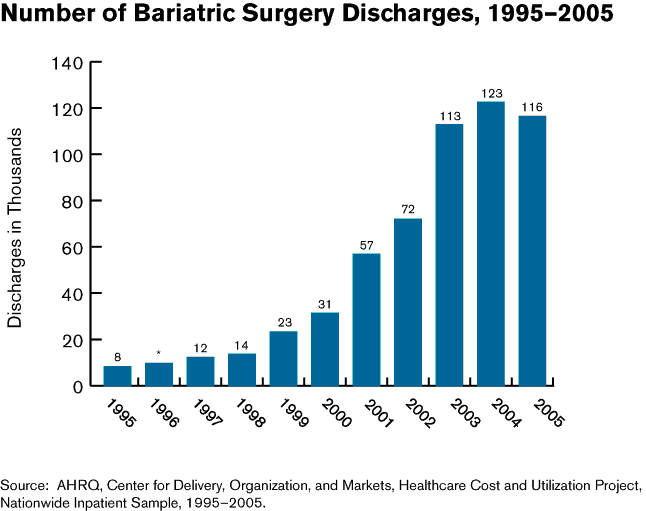
Bariatric surgery reduces the size of the stomach to achieve weight loss for people who are morbidly obese. It may be used to control the effects of serious medical conditions, such as diabetes.
1Bradley DW, Sharma BK. Centers of Excellence in Bariatric Surgery: design, implementation, and one-year outcomes. Surgery for Obesity and Related Diseases. 2006 Sep-Oct;2(5):513-7; Nguyen NT, Paya M, Stevens CM, Mavandadi S, Zainabadi K, Wilson SE. The relationship between hospital volume and outcome in bariatric surgery at academic medical centers. Annals of Surgery. 2004 Oct;240(4):586-93.
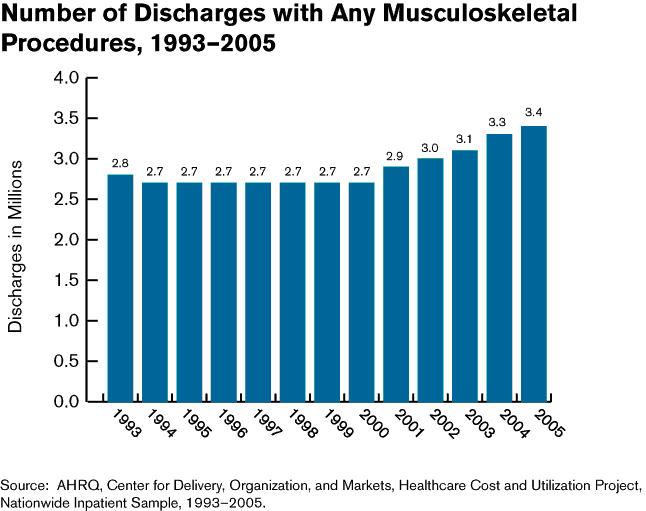
Hospital stays for musculoskeletal treatments often involve repair of fractures and joint procedures to relieve pain.
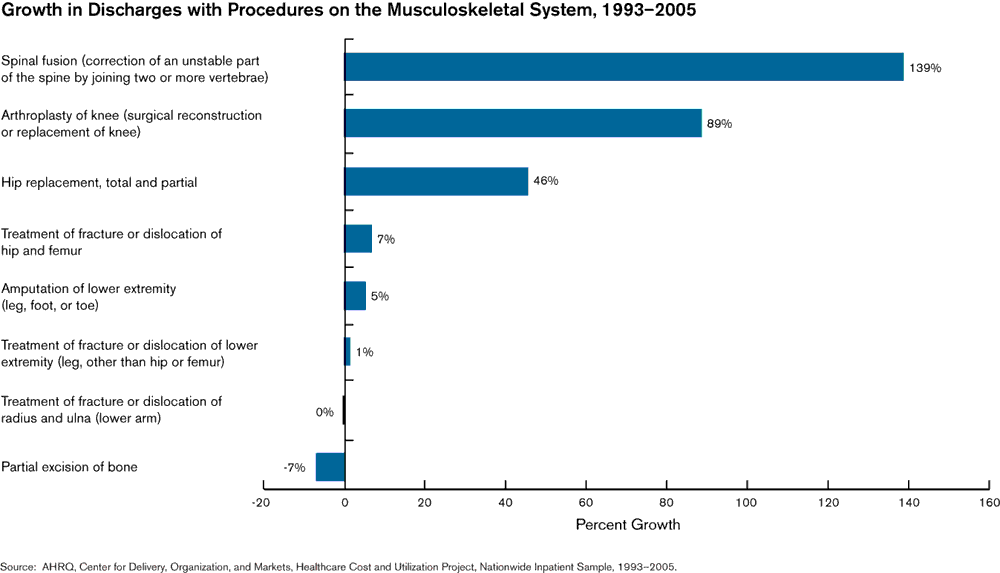
Taken together, the most frequent musculoskeletal (or orthopedic) procedures increased with age, but the distribution of specific treatments differed by age group in 2005.
For patients less than 18 years of age:
For patients 18–44 years of age:
For patients 45–64 years of age:
For patients 65–84 years of age:
For patients 85 years of age and older:
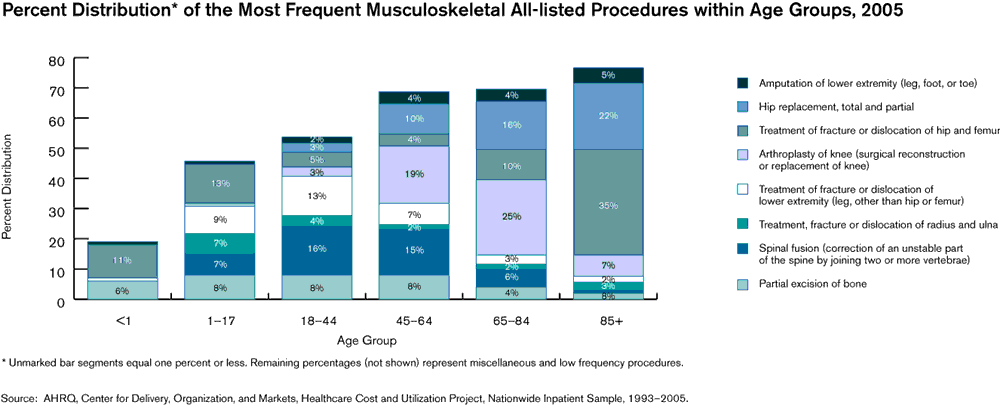
| Principal Diagnosis | Total Inflation-adjusted* Hospital Costs in Millions | Percent of Total Costs | Rank | ||||||
|---|---|---|---|---|---|---|---|---|---|
| 1997 | 2004 | 2005 | 1997 | 2004 | 2005 | 1997 | 2004 | 2005 | |
| All diagnoses | $209.2 | $303.5 | $310.9 | 100 | 100 | 100 | |||
| Coronary atherosclerosis (coronary artery disease) | 14.0 | 16.3 | 15.5 | 7 | 5 | 5 | 1 | 1 | 1 |
| Acute myocardial infarction (heart attack) | 8.7 | 11.6 | 10.9 | 4 | 4 | 4 | 2 | 2 | 2 |
| Pneumonia (except that caused by tuberculosis or sexually transmitted disease) | 8.5 | 10.1 | 10.7 | 4 | 3 | 3 | 3 | 5 | 3 |
| Congestive heart failure, nonhypertensive | 6.4 | 10.7 | 10.5 | 3 | 4 | 3 | 5 | 3 | 4 |
| Liveborn (newborn infant) | 7.6 | 10.6 | 9.8 | 4 | 3 | 3 | 4 | 4 | 5 |
| Osteoarthritis (degenerative joint disease) | 4.5 | 8.7 | 9.7 | 2 | 3 | 3 | 8 | 6 | 6 |
| Complication of medical device, implant or graft | 5.3 | 8.4 | 8.9 | 3 | 3 | 3 | 6 | 7 | 7 |
| Septicemia (blood infection) | 3.9 | 6.7 | 8.4 | 2 | 2 | 3 | 9 | 8 | 8 |
| Spondylosis, intervertebral disc disorders, other back problems (disorders of intervertebral discs and bones on spinal column) | 3.3 | 6.5 | 7.1 | 2 | 2 | 2 | 12 | 9 | 9 |
| Adult respiratory failure, insufficiency, or arrest | 3.2 | 5.4 | 7.0 | 2 | 2 | 2 | 15 | 12 | 10 |
| Cardiac dysrhythmias (irregular heart beat) | 3.4 | 6.2 | 6.0 | 2 | 2 | 2 | 11 | 11 | 11 |
| Acute cerebrovascular disease (stroke) | 5.2 | 6.2 | 5.9 | 2 | 2 | 2 | 7 | 10 | 12 |
| Rehabilitation care, fitting of prostheses, and adjustment of devices | 3.6 | 5.1 | 5.1 | 2 | 2 | 2 | 10 | 13 | 13 |
| Complications of surgical procedures or medical care | 2.8 | 4.6 | 4.7 | 1 | 2 | 2 | 18 | 14 | 14 |
| Chronic obstructive pulmonary disease and bronchiectasis (chronic obstructive lung disease) | 3.2 | 3.8 | 4.2 | 2 | 1 | 1 | 14 | 17 | 15 |
| Biliary tract disease (gall bladder disease) | 3.2 | 4.1 | 4.1 | 2 | 1 | 1 | 13 | 15 | 16 |
| Diabetes mellitus with complications | 2.6 | 4.0 | 3.9 | 1 | 1 | 1 | 19 | 16 | 17 |
| Fracture of neck of femur (hip fracture) | 3.0 | 3.8 | 3.9 | 1 | 1 | 1 | 16 | 18 | 18 |
| Non-specific chest pain | 1.6 | 3.6 | 3.5 | 1 | 1 | 1 | 36 | 20 | 19 |
| Mood disorders (depression and bipolar disorders) | 3.0 | 3.6 | 3.4 | 1 | 1 | 1 | 17 | 19 | 20 |
| Total for top 20 conditions | 96.7 | 140.0 | 142.9 | 46 | 46 | 46 | |||
| Source: Healthcare Cost and Utilization Project (HCUP), Agency for Healthcare Research and Quality. *Adjusted for inflation using the GDP deflator (http://www.bea.gov/national/nipaweb/TableView.asp#Mid, Table 1.1.4. Price Indexes for Gross Domestic Product) |
|||||||||
The top 20 principal diagnoses with the highest aggregate inpatient hospital costs represented 46 percent of the $310.9 billion total cost for all stays in U.S. community hospitals in 2005, the same share as in 1997 and 2004.
The most costly diagnoses:
Increasing costs:
Stable or decreasing costs:
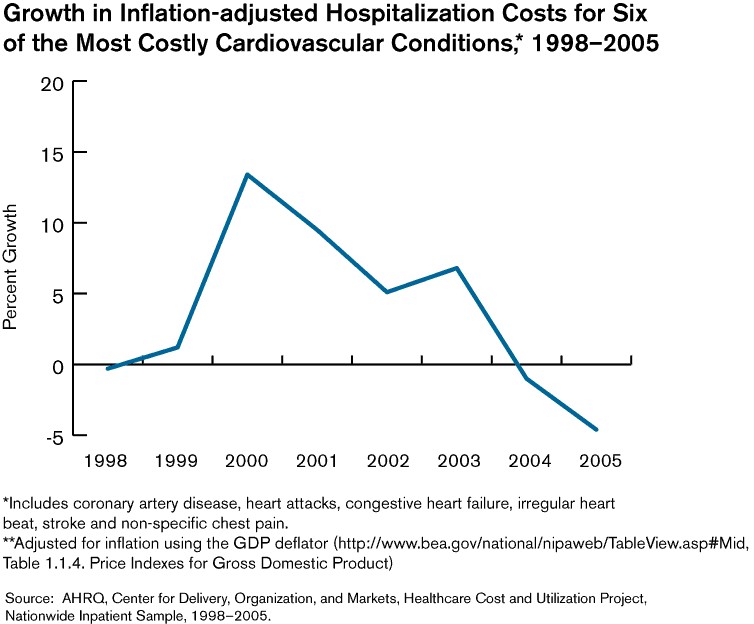
Hospital charges are the amounts usually seen by a patient when they receive their hospital bill. However, charges seldom represent what is actually paid for hospital stays because of negotiated discounts, but they do offer a useful benchmark for comparing the relative costliness of conditions.
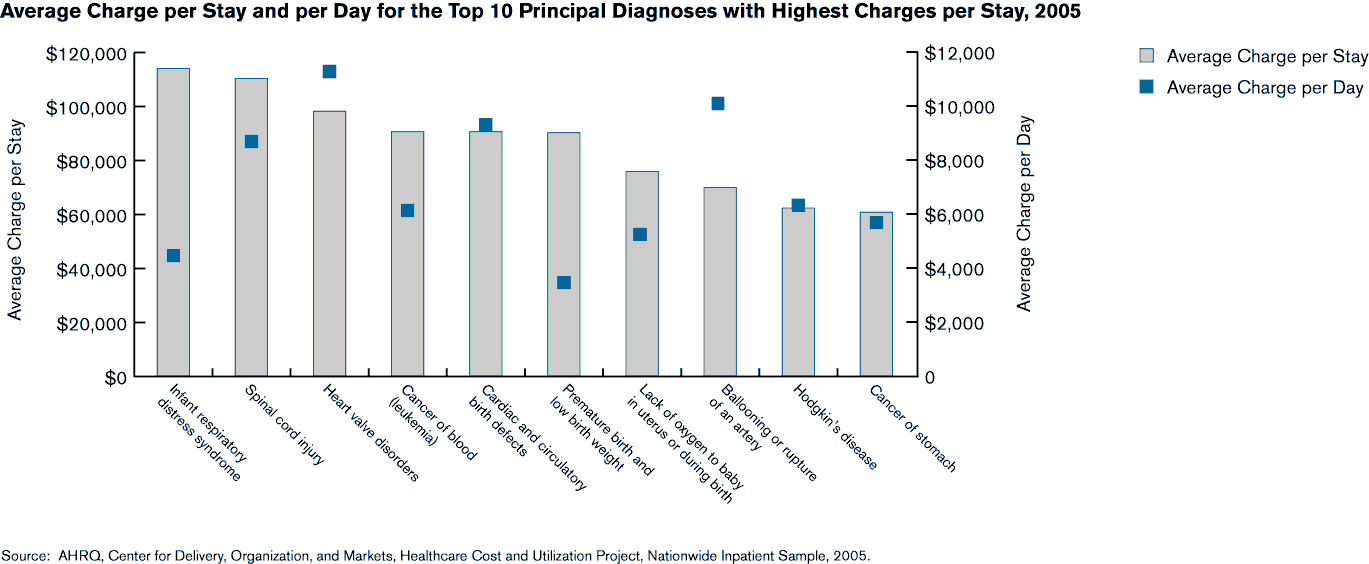
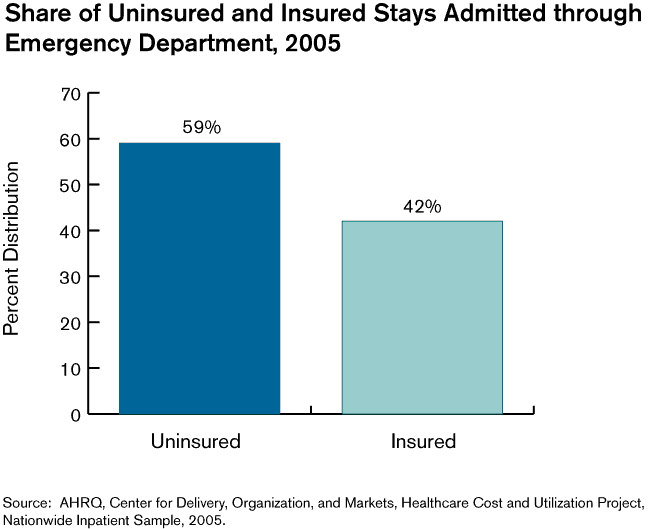
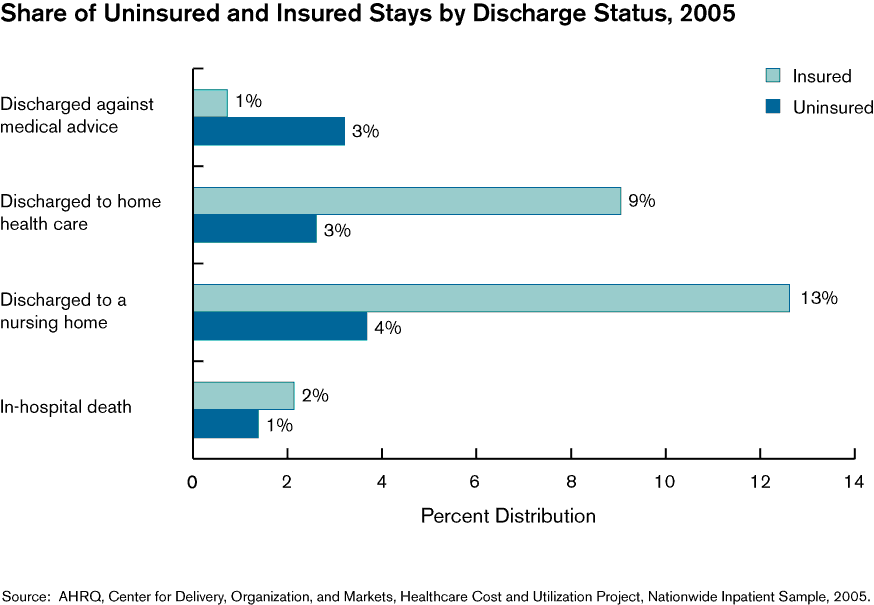
Five percent (nearly 2.1 million) of the 39.2 million U.S. community hospital discharges in 2005 were considered uninsured because they were not covered by private insurance or public programs.
Admission Source:
Discharge Status:
Unit of Analysis
The unit of analysis is the hospital stay rather than the patient. All discharges have been weighted to produce national estimates.
Coding Diagnoses and Procedures
The diagnoses and procedures associated with an inpatient hospitalization can be defined using several different medical condition classification systems. The following four systems are used within this report to identify specific diagnoses and procedures: International Classification of Diseases, 9th Revision, Clinical Modification (ICD-9-CM), Clinical Classifications Software (CCS), Diagnosis Related Groups (DRGs), and Major Diagnostic Categories (MDCs).
The most detailed system is the ICD-9-CM that contains over 12,000 detailed diagnoses and 3,500 detailed procedures. Each discharge record in the NIS is associated with one or more ICD-9-CM diagnosis code(s) and may contain one or more ICD-9-CM procedure code(s) if a procedure was performed during that hospitalization.
To make the number of ICD-9-CM diagnoses and procedures more manageable, AHRQ has designed the CCS tool that groups ICD-9-CM codes into 260 diagnostic and 231 procedure categories. This software aggregates similar diagnoses or procedures into clinically meaningful categories. More information on CCS can be found online (www.ahrq.gov/data/hcup/; http://www.hcup-us.ahrq.gov/toolssoftware/ccs/ccs.jsp). CCS codes are used extensively in this report to define groups of diagnoses and procedures for analysis. The CCS codes allow the reader to quickly and easily recognize patterns and trends in broad categories of hospital utilization.
In addition, diagnoses can also be grouped into DRGs. DRGs comprise a classification system that categorizes patients into groups that are clinically coherent and homogeneous with respect to resource use. DRGs group patients according to diagnosis, type of treatment (procedures), age, and other relevant criteria. Each hospital stay has one DRG assigned to it. The Centers for Medicare and Medicaid Services (CMS) uses this classification system as a basis for Medicare payments for inpatient hospital stays.
DRGs, in turn, can be summarized into MDCs, which are broad groups of DRGs such as Diseases and Disorders of the Nervous System or Diseases and Disorders of the Eye. Each hospital stay has one DRG and one MDC assigned to it.
Exhibit Diagnoses and Procedures
Throughout this report, combinations of diagnostic and procedure codes are used to isolate specific conditions or procedures. These codes are defined below by exhibit number.
Maternal CCS categories:
183 Hypertension complicating pregnancy, childbirth, and the puerperium (high blood pressure during pregnancy)
184 Early or threatened labor
185 Prolonged pregnancy
189 Previous C-section
190 Fetal distress and abnormal forces of labor
191 Polyhydramnios and other problems of amniotic cavity (excess amniotic fluid and other problems of amniotic cavity)
192 Umbilical cord complication
193 Trauma to external female genitals (vulva) and area between anus and vagina (perineum)
196 Normal pregnancy and/or delivery
Other maternal CCS categories:
176 Contraceptive and procreative management (birth control or helping with conception)
177 Spontaneous abortion
178 Induced abortion
179 Postabortion complications (complications following abortion)
180 Ectopic pregnancy (abdominal or tubal pregnancy)
181 Other complications of pregnancy
182 Hemorrhage during pregnancy, abruptio placenta, placenta previa (bleeding and placenta disorders during pregnancy)
186 Diabetes or abnormal glucose tolerance complicating pregnancy, childbirth, or the puerperium (diabetes or high blood glucose during pregnancy)
187 Malposition, malpresentation (breech birth and other disorders of baby’s position during birth)
188 Obstructed labor or fetopelvic disproportion
194 Forceps delivery
195 Other maternal complications of birth, puerperium affecting management of mother (other maternal complications of birth and period after childbirth)
Infant CCS categories:
218 Liveborn (newborn infant)
219 Short gestation, low birth weight, and fetal growth retardation (premature birth and low birth weight)
220 Intrauterine hypoxia and birth asphyxia (lack of oxygen to baby in uterus or during birth)
221 Infant respiratory distress syndrome
222 Hemolytic jaundice and perinatal jaundice (infant jaundice following birth)
223 Birth trauma
224 Other perinatal conditions (other conditions occurring around the time of birth)
Circulatory CCS categories:
99 Hypertension with complications and secondary hypertension (high blood pressure with complications)
100 Acute myocardial infarction (heart attack)
101 Coronary atherosclerosis (coronary artery disease)
102 Non-specific chest pain
106 Cardiac dysrhythmias (irregular heart beat)
108 Congestive heart failure, nonhypertensive
109 Acute cerebrovascular disease (stroke)
110 Occlusion or stenosis of precerebral arteries (blockage of arteries before brain)
112 Transient cerebral ischemia (mini-stroke)
114 Peripheral and visceral atherosclerosis (hardening of arteries outside heart)
118 Phlebitis, thrombophlebitis, and thromboembolism (inflammation and blood clots in the veins)
Other circulatory CCS categories:
96 Heart valve disorders
97 Peri-, endo-, and myocarditis, cardiomyopathy (disorders of heart muscle and surrounding tissue, except that caused by tuberculosis or sexually transmitted disease)
98 Essential hypertension (high blood pressure)
103 Pulmonary heart disease (heart disease due to lung disorders)
104 Other and ill-defined heart disease
105 Conduction disorders (disturbance of electrical activity of heart)
107 Cardiac arrest and ventricular fibrillation (uncoordinated contraction of heart)
111 Other and ill-defined cerebrovascular disease (other blockage of brain blood supply)
113 Late effects of cerebrovascular disease (late effects of stroke)
115 Aortic, peripheral, and visceral artery aneurysms (ballooning or rupture of an artery)
116 Aortic and peripheral arterial embolism or thrombosis (arterial blood clots)
117 Other circulatory disease (other blood vessel disease)
119 Varicose veins of lower extremity (varicose veins in leg)
120 Hemorrhoids
121 Other diseases of veins and lymphatics (lymph system)
Diabetes CCS categories:
49 Diabetes mellitus without complication
50 Diabetes mellitus with complications
Pressure sore ICD-9-CM codes:
707.0 Decubitus ulcer
707.00 Decubitus ulcer, unspecified site
707.01 Decubitus ulcer, elbow
707.02 Decubitus ulcer, upper back
707.03 Decubitus ulcer, lower back
707.04 Decubitus ulcer, hip
707.05 Decubitus ulcer, buttock
707.06 Decubitus ulcer, ankle
707.07 Decubitus ulcer, heel
707.09 Decubitus ulcer, other site
Alcoholism and alcohol abuse ICD-9-CM codes:
291.0 Alcohol withdrawal delirium
291.1 Alcohol-induced persisting amnestic disorder
291.2 Alcohol-induced persisting dementia
291.3 Alcohol-induced psychotic disorder with hallucinations
291.4 Idiosyncratic alcohol intoxication
291.5 Alcohol-induced psychotic disorder with delusions
291.8 Other specified alcohol-induced mental disorders
291.81 Alcohol withdrawal
291.82 Alcohol-induced sleep disorders
291.89 Other
291.9 Unspecified alcohol-induced mental disorders
303.00 Acute alcoholic intoxication, unspecified
303.01 Acute alcoholic intoxication, continuous
303.02 Acute alcoholic intoxication, episodic
303.03 Acute alcoholic intoxication, in remission
303.90 Other and unspecified alcohol dependence, unspecified
303.91 Other and unspecified alcohol dependence, continuous
303.92 Other and unspecified alcohol dependence, episodic
303.93 Other and unspecified alcohol dependence, in remission
305.00 Alcohol abuse, unspecified
305.01 Alcohol abuse, continuous
305.02 Alcohol abuse, episodic
305.03 Alcohol abuse, in remission
357.5 Alcoholic polyneuropathy
425.5 Alcoholic cardiomyopathy
535.3 Alcoholic gastritis
535.31 Alcoholic gastritis, with hemorrhage
571.0 Alcoholic fatty liver
571.1 Acute alcoholic hepatitis
571.2 Alcoholic cirrhosis of liver
571.3 Alcoholic liver damage, unspecified
760.71 Noxious influences affecting fetus or newborn via placenta or breast milk, alcohol
790.3 Excessive blood level of alcohol
V11.3 Personal history of mental disorder, alcoholism
V79.1 Special screening for mental disorders and developmental handicaps, alcoholism
Mental health CCS categories:
650 Adjustment disorders
652 Attention-deficit, conduct, and disruptive behavior disorders
653 Delirium, dementia, and amnestic and other cognitive disorders
657 Mood disorders
659 Schizophrenia and other psychotic disorders
660 Substance-related disorders
Other mental health CCS categories:
651 Anxiety disorders
654 Developmental disorders
655 Disorders usually diagnosed in infancy, childhood, or adolescence
656 Impulse control disorders, not elsewhere classified
658 Personality disorders
661 Miscellaneous mental disorders
Injury CCS categories:
225 Joint disorders and dislocations, trauma-related
226 Fracture of neck of femur (hip fracture)
227 Spinal cord injury
228 Skull and face fractures
229 Fracture of upper limb (arm)
230 Fracture of lower limb (leg)
231 Other fractures
232 Sprains and strains
233 Intracranial injury (brain injury)
234 Crushing injury or internal injury
235 Open wounds of head, neck, and trunk
236 Open wounds of extremities (arms and legs)
239 Superficial injury, contusion (bruise)
240 Burns
241 Poisoning by psychotropic agents (psychiatric drugs)
242 Poisoning by other medications and drugs
243 Poisoning by nonmedicinal substances (substances other than medicine)
244 Other injuries and conditions due to external causes
Influenza CCS category:
123 Influenza
Because the NIS is limited to inpatient hospital data, conditions treated or procedures performed in outpatient settings are not reflected here.
Childbirth DRG categories:
370 Cesarean section with complications and comorbidities
371 Cesarean section without complications and comorbidities
372 Vaginal delivery with complicating diagnoses
373 Vaginal delivery without complicating diagnoses
374 Vaginal delivery with sterilization and/or dilation and curettage
375 Vaginal delivery with operating room procedure except sterilization and/or dilation and curettage
Within DRG 370-371 and 372-375, all-listed diagnoses were also subsetted using the following CCS diagnosis category:
189 Previous C-section
Cardiovascular CCS categories:
44 CABG (coronary artery bypass graft, procedure to restore blood supply to the heart muscle)
45 PTCA (percutaneous transluminal coronary angioplasty, procedure involving use of a balloon-tipped catheter to enlarge a narrowed artery)
51 Endarterectomy (surgical removal of an obstructing clot from the arteries of the neck and head)
In addition, abdominal aortic aneurysm repair was defined using the following ICD-9-CM procedures and diagnoses:
Bariatric surgery procedures were identified using these steps:
1) identify likely bariatric procedures using ICD-9-CM procedure codes; 2) identify additional likely stays for bariatric surgeries using a combination of DRG and ICD-9-CM categories; 3) remove stays where the procedures were performed because of cancer; and 4) eliminate cases where an obesity diagnosis was not present.
1) Bariatric procedures using ICD-9-CM procedure codes:
44.31 High gastric bypass
44.38 Laparoscopic gastroenterostomy
44.39 Other gastroenterostomy
44.68 Laparoscopic gastroplasty
44.69 Other
44.95 Laparoscopic gastric restrictive procedure
44.96 Laparoscopic revision of gastric restrictive procedure
44.97 Laparoscopic removal of gastric restrictive device(s)
44.98 (Laparoscopic) adjustment of size of adjustable gastric restrictive device
2) Additional likely stays for bariatric surgeries. If the DRG was equal to 288 (O.R. procedures for obesity), additional bariatric surgery procedures were defined using the following ICD-9-CM categories:
44.5 Revision of gastric anastomosis
44.99 Other operations on the stomach
45.91 Small-to-small intestinal anastomosis
3) For all cases above, exclude cancer cases defined by the following ICD-9-CM diagnosis categories:
150.0-159.9 Malignant neoplasm of digestive organs and peritoneum
230.1-230.9 Carcinoma in situ of digestive organs
4) Exclude cases without one of the following ICD-9-CM diagnostic codes for obesity:
278.0 Obesity
278.00 Obesity, unspecified
278.01 Morbid obesity
V77.8 Obesity
Orthopedic procedure CCS categories:
142 Partial excision of bone
145 Treatment of fracture or dislocation of radius and ulna (lower arm)
146 Treatment of fracture or dislocation of hip and femur
147 Treatment of fracture or dislocation of lower extremity (leg, other than hip or femur)
152 Arthroplasty of knee (surgical reconstruction or replacement of knee)
153 Hip replacement, total and partial
157 Amputation of lower extremity (leg, foot, or toe)
158 Spinal fusion (correction of an unstable part of the spine by joining two or more vertebrae)
Other orthopedic procedure CCS categories:
143 Bunionectomy (repair of toe deformities)
144 Treatment of facial fracture or dislocation
148 Other fracture and dislocation procedure
149 Arthroscopy (procedure to view the inside of a joint through a lighted tube and to diagnose and treat problems)
150 Division of joint capsule, ligament or cartilage
151 Excision of semilunar cartilage of knee
154 Arthroplasty other than hip or knee (surgical reconstruction or replacement of other joints)
155 Arthrocentesis (procedure that involves introducing a needle into a joint to remove joint fluid)
156 Injections and aspirations of muscles, tendons, bursa, joints, and soft tissue
159 Other diagnostic procedures on musculoskeletal system
160 Other therapeutic procedures on muscles and tendons
161 Other operating room therapeutic procedures on bone
162 Other operating room therapeutic procedures on joints
163 Other non-operating room therapeutic procedures on musculoskeletal system
164 Other operating room therapeutic procedures on musculoskeletal system
Admission source
Admission source indicates where the patient was located prior to admission to the hospital.
Adjusted for inflation
Cost can be adjusted for economy-wide inflation by removing increases that reflect the effect of changing average prices for all goods and services. In this report, the U.S. Bureau of Economic Analysis Gross Domestic Product Price Index is used to remove economy-wide inflation. Additional inflation that is specific to the hospital sector is not removed in this calculation. Data in Exhibit 1.1 and 4.1 are adjusted for economy-wide inflation.
Aggregate costs
Aggregate costs are the sum of all costs for all hospital stays.
Charges
Hospital charges reflect the amount the hospital billed for the entire hospital stay and do not include professional (physician) fees. The charge is generally more than the amount paid to the hospital by payers for the hospitalization and is also generally more than the hospital’s costs of care.
Community hospitals
HCUP is based on data from community hospitals, defined as short-term, non-Federal, general and other hospitals, excluding hospital units of other institutions (e.g., prisons). Community hospitals (and HCUP data) include OB-GYN, ENT, orthopedic, cancer, pediatric, public, and academic medical hospitals. They exclude hospitals whose main focus is long-term care, psychiatric, and alcoholism and chemical dependency treatment, although discharges from these types of units that are part of community hospitals are included.
Costs
Costs are derived from total hospital charges using cost-to-charge ratios based on hospital accounting reports from the Centers for Medicare and Medicaid Services (CMS). Costs will tend to reflect the actual costs to produce hospital services, while charges represent what the hospital billed for the case. For each hospital, a hospital-wide cost-to-charge ratio is used to transform charges into costs. Cost-to-charge ratios for 2005 will not be available until later this year. These ratios were estimated by multiplying the 2004 ratio for each hospital by .96, which represents the average annual change exhibited in the charge-to-cost ratios over the past few years.
Discharge
Discharge refers to the hospital stay. The unit of analysis for HCUP data is the hospital discharge, not a person or patient. This means that a person who is admitted to the hospital multiple times in one year will be counted each time as a separate discharge from the hospital.
Discharge status
Discharge status indicates the disposition of the patient at the time of discharge from the hospital, and includes the following six categories: routine (to home), transfer to another short-term hospital, other transfers (including skilled nursing facility, intermediate care, rehabilitation care, swing bed, and another type of facility such as a nursing home), home healthcare, against medical advice (AMA), or died in the hospital.
Discharge per population
Discharge per population is the hospital discharge rate of a particular procedure, diagnosis, or event per 100,000 individuals. This measure indicates the prevalence of hospitalizations, procedures or diagnoses within the population.
In-hospital deaths
In-hospital deaths refer to hospitalizations in which the patient died during his or her hospital stay.
Infant discharges
Infant discharges are hospital stays during which a child is born.
Length of stay
Length of stay is the number of nights the patient remained in the hospital for his or her stay. A patient admitted and discharged on the same day has a length of stay equal to 0.
Maternal discharges
Maternal discharges are hospital stays for females who are pregnant or gave birth.
Median income
Median income is the median household income of the patient’s ZIP Code of residence. This is a proxy measure of a patient’s socioeconomic status.
Morbid obesity
Morbid obesity is defined as at least twice a person’s ideal weight, 100 pounds overweight, or a body mass index (BMI) that is greater than 39.
Neonates
Neonates are newborns and infants 30 days of age or less.
Ownership/control
Ownership/control was obtained from the American Hospital Association (AHA) Annual Survey of Hospitals and includes categories for government non-Federal (public), private not-for-profit (voluntary), and private investor-owned (proprietary).
These types of hospitals tend to have different missions and different responses to government regulations and policies.
Patient age
Patient age in years, calculated based on the patient’s date of birth and admission date to the hospital.
Payers
Payer is the expected payer for the hospital stay. To make coding uniform across all HCUP data sources, Payer combines detailed categories into more general groups:
When more than one payer is listed for a hospital discharge, the first-listed payer is used.
Region
Region is one of the four regions defined by the U.S. Bureau of the Census: Northeast, Midwest, South, and West.
Not all states participate in HCUP, so not all states will be present in HCUP data. However, the statistics have been weighted to represent the entire U.S.
Stays
The unit of analysis for HCUP data is the hospital stay (i.e., the hospital discharge), not a person or patient. This means that a person who is admitted to the hospital multiple times in one year will be counted each time as a separate "discharge" from the hospital.
HCUP Background Information
For a detailed description of HCUP, information on the design of the NIS, and methods to calculate estimates, please refer to the following publications:
Steiner C, Elixhauser A, Schnaier J. The Healthcare Cost and Utilization Project: An Overview. Effective Clinical Practice 5(3):143–51, 2002.
Design of the HCUP Nationwide Inpatient Sample, 2005. Online. June 13, 2007. U.S. Agency for Healthcare Research and Quality. http://www.hcup-us.ahrq.gov/db/nation/nis/reports/NIS_2005_Design_Report.pdf
Houchens R, Elixhauser A. Final Report on Calculating Nationwide Inpatient Sample (NIS) Variances, 2001. HCUP Methods Series Report #2003-2. Online. June 2005 (revised June 6, 2005). U.S. Agency for Healthcare Research and Quality. https://www.hcup-us.ahrq.gov/reports/methods/2003_02.pdf
Houchens RL, Elixhauser A. Using the HCUP Nationwide Inpatient Sample to Estimate Trends. (Updated for 1988-2004). HCUP Methods Series Report #2006-05 Online. August 18, 2006. U.S. Agency for Healthcare Research and Quality. http://www.hcup-us.ahrq.gov/reports/methods/2006_05_NISTrendsReport_1988-2004.pdf
HCUP Statistics and Website
For additional HCUP statistics, visit HCUPnet, our interactive query system at http://hcup.ahrq.gov.
Technical Assistance
For Technical Assistance with HCUP Products:
E-mail: hcup@ahrq.gov
Phone: 1-866-290-HCUP
Thanks to Eva Witt and Nils Nordstrand at Thomson Healthcare for their programming support; Laurel Holmquist and Anne Pfuntner at Thomson Healthcare for their assistance in the preparation of tables and text; Gail Eisen, also at Thomson Healthcare, for her editorial assistance; Roxanne Andrews, Pamela Owens, and Claudia Steiner of AHRQ for contributions to early content decisions; and The Madison Design Group for their assistance in design and layout of the report. Special thanks to Chaya Merrill of Thomson Healthcare and Megan Hambrick of AHRQ for their helpful comments on drafts. This document draws from and updates previously published HCUP Fact Books and Statistical Briefs, which can be found at http://www.hcup-us.ahrq.gov/reports.jsp and http://www.hcup-us.ahrq.gov/reports/statbriefs/sbtopic.jsp.
Levit K, Ryan K, Elixhauser A, Stranges E, Kassed C, Coffey R. HCUP Facts and Figures: Statistics on Hospital-based Care in the United States in 2005. Rockville, MD: Agency for Healthcare Research and Quality, 2007. http://www.hcup-us.ahrq.gov/reports.jsp
| Internet Citation: Facts and Figures 2005. Healthcare Cost and Utilization Project (HCUP). February 2011. Agency for Healthcare Research and Quality, Rockville, MD. hcup-us.ahrq.gov/reports/factsandfigures/facts_figures_2005.jsp. |
| Are you having problems viewing or printing pages on this website? |
| If you have comments, suggestions, and/or questions, please contact hcup@ahrq.gov. |
| If you are experiencing issues related to Section 508 accessibility of information on this website, please contact hcup@ahrq.gov. |
| Privacy Notice, Viewers & Players |
| Last modified 2/1/11 |